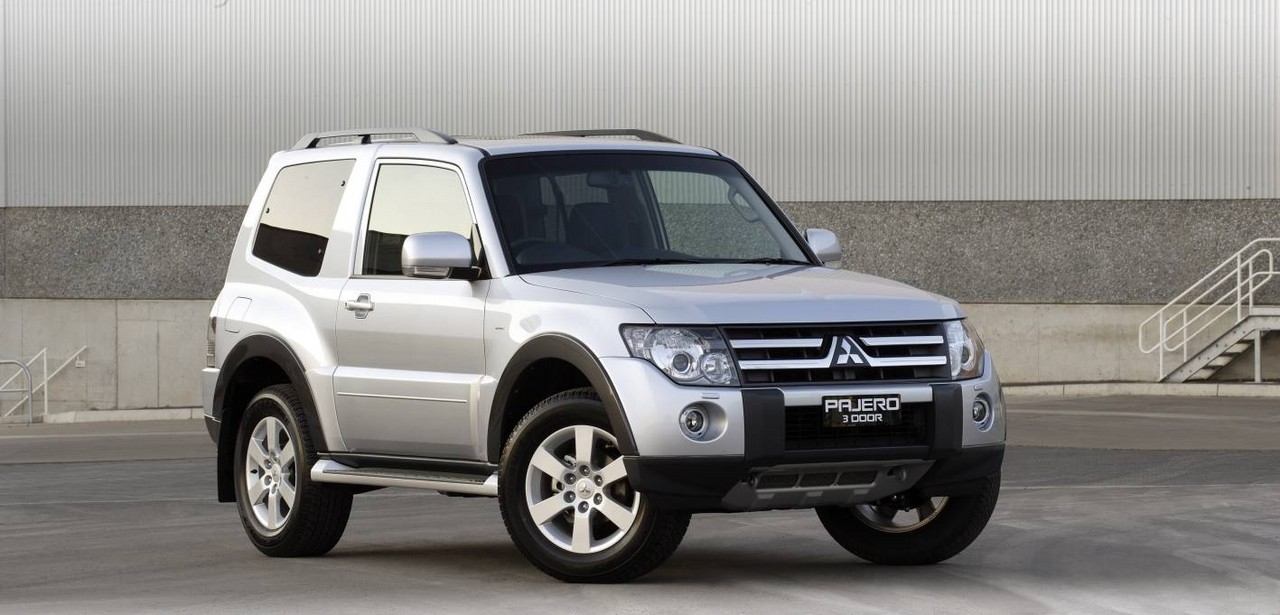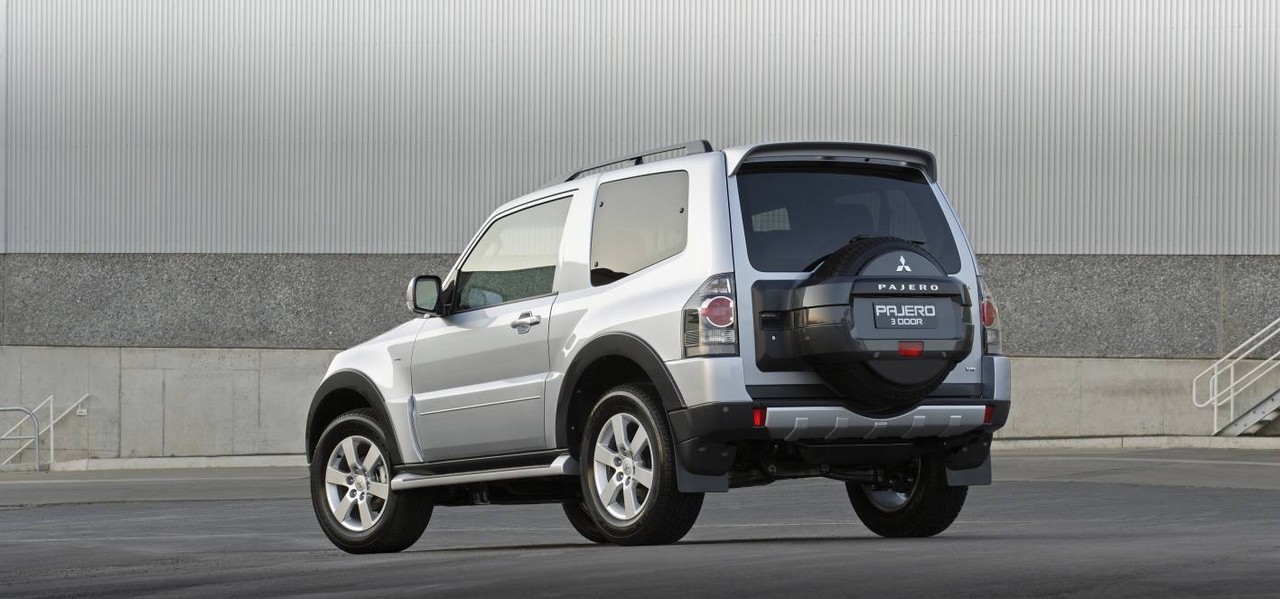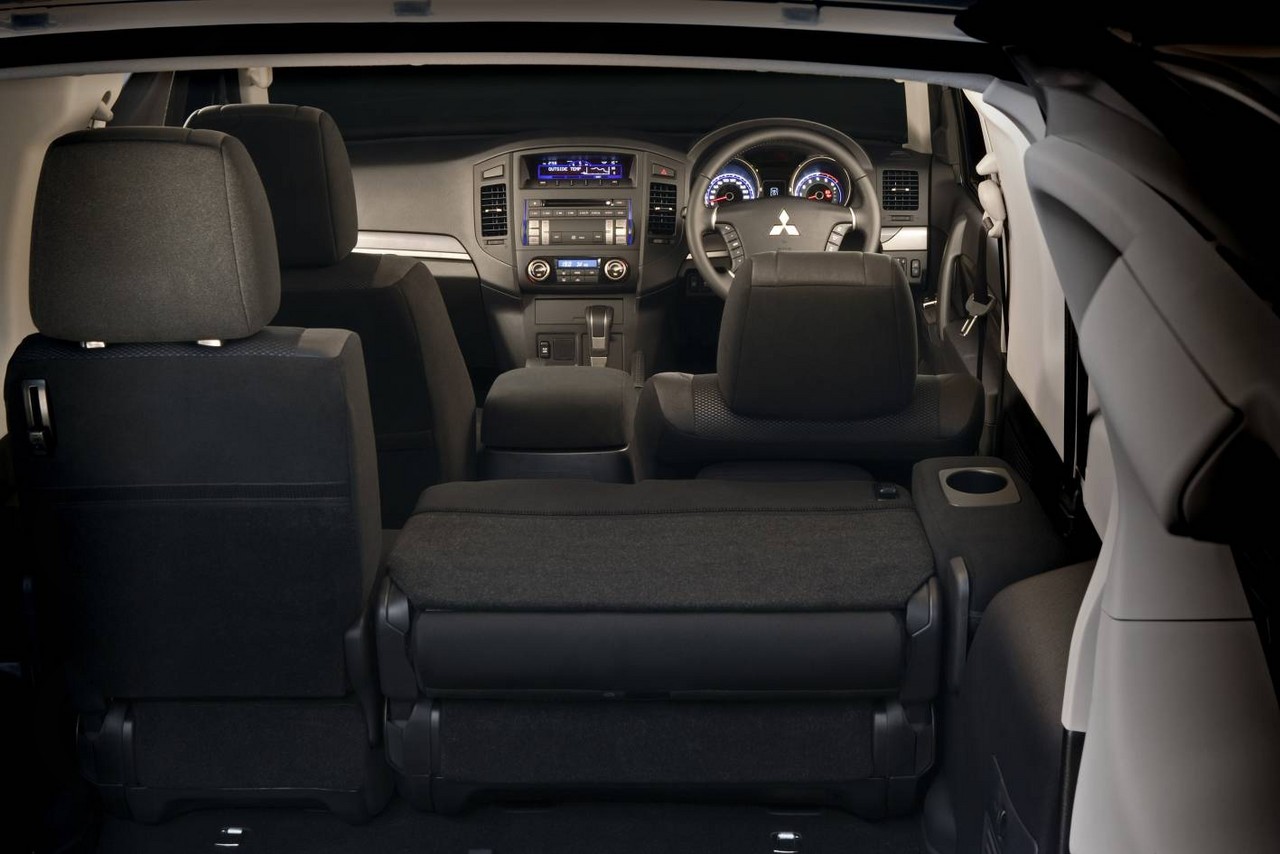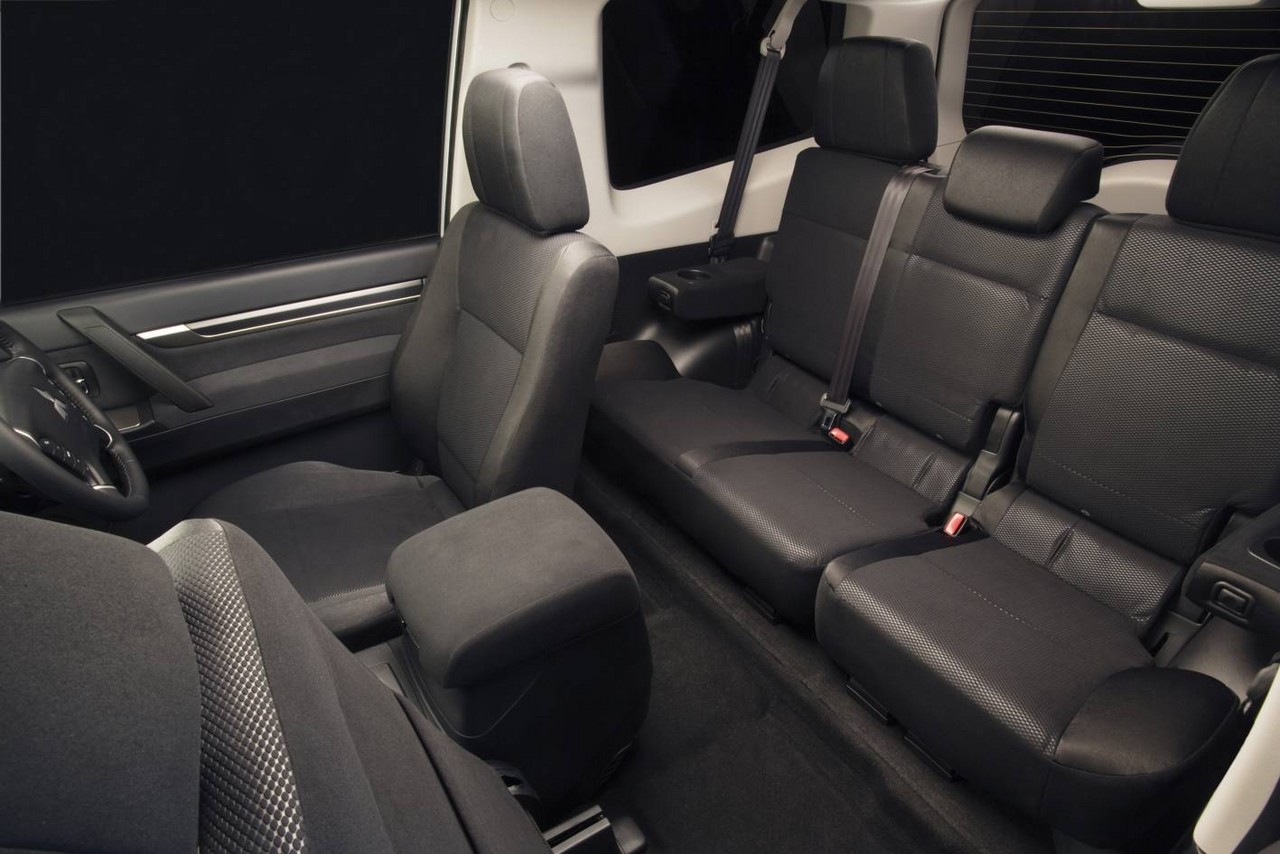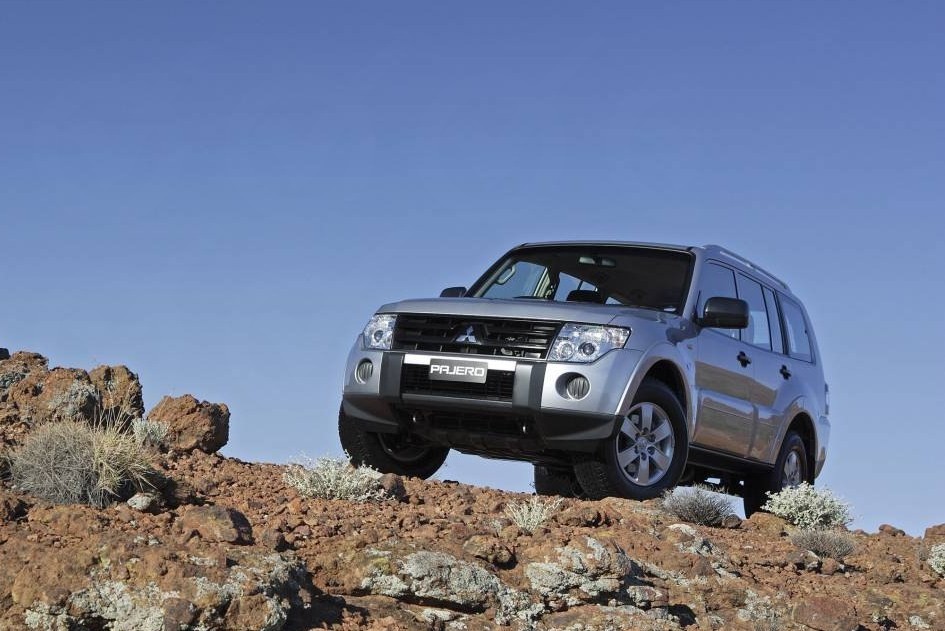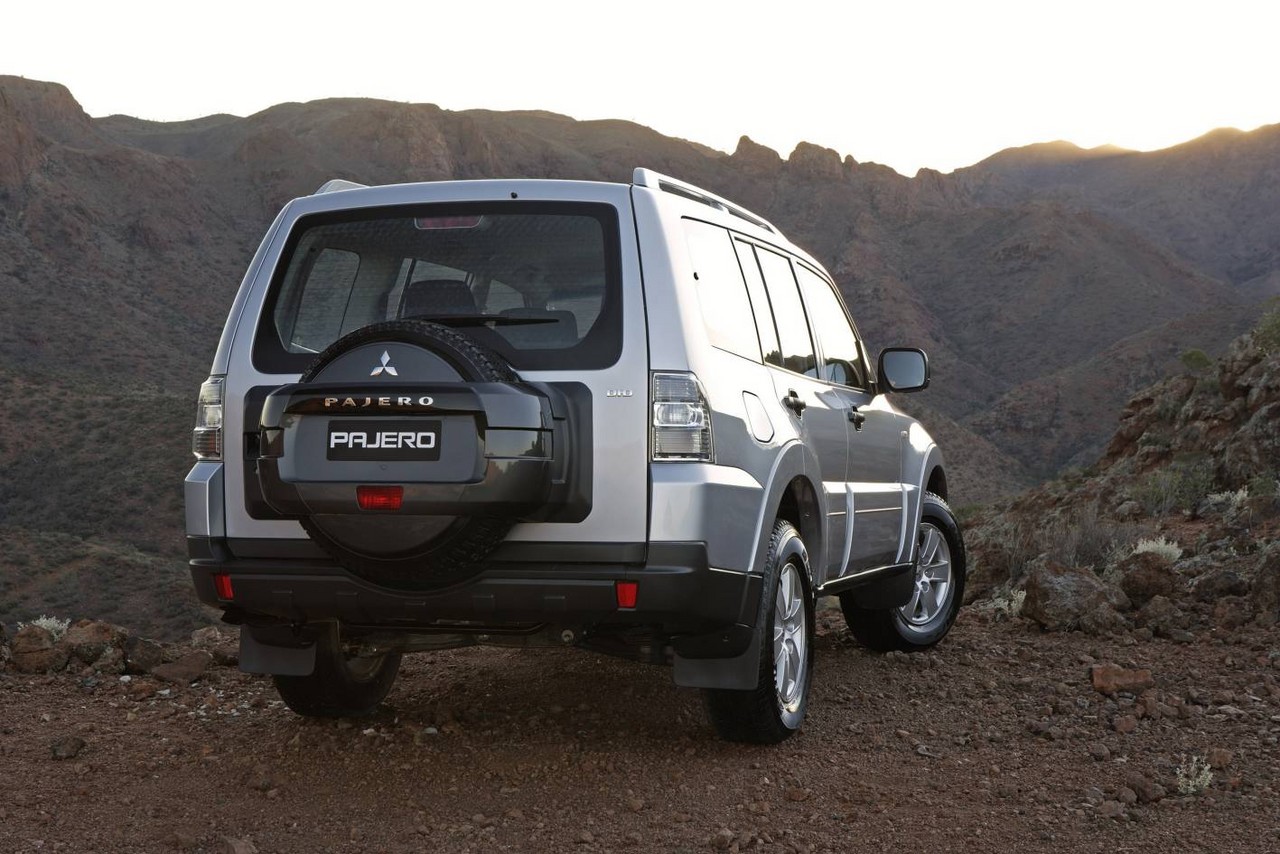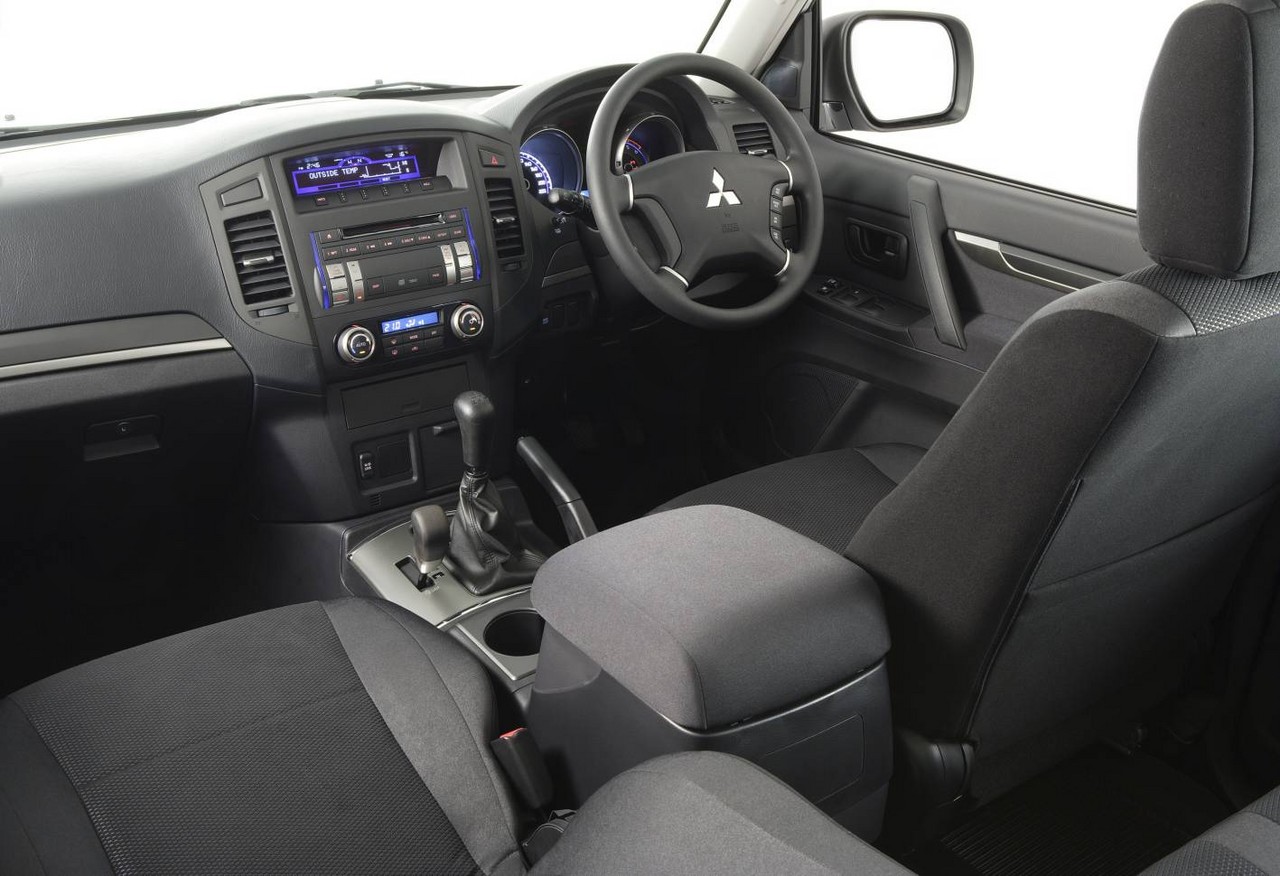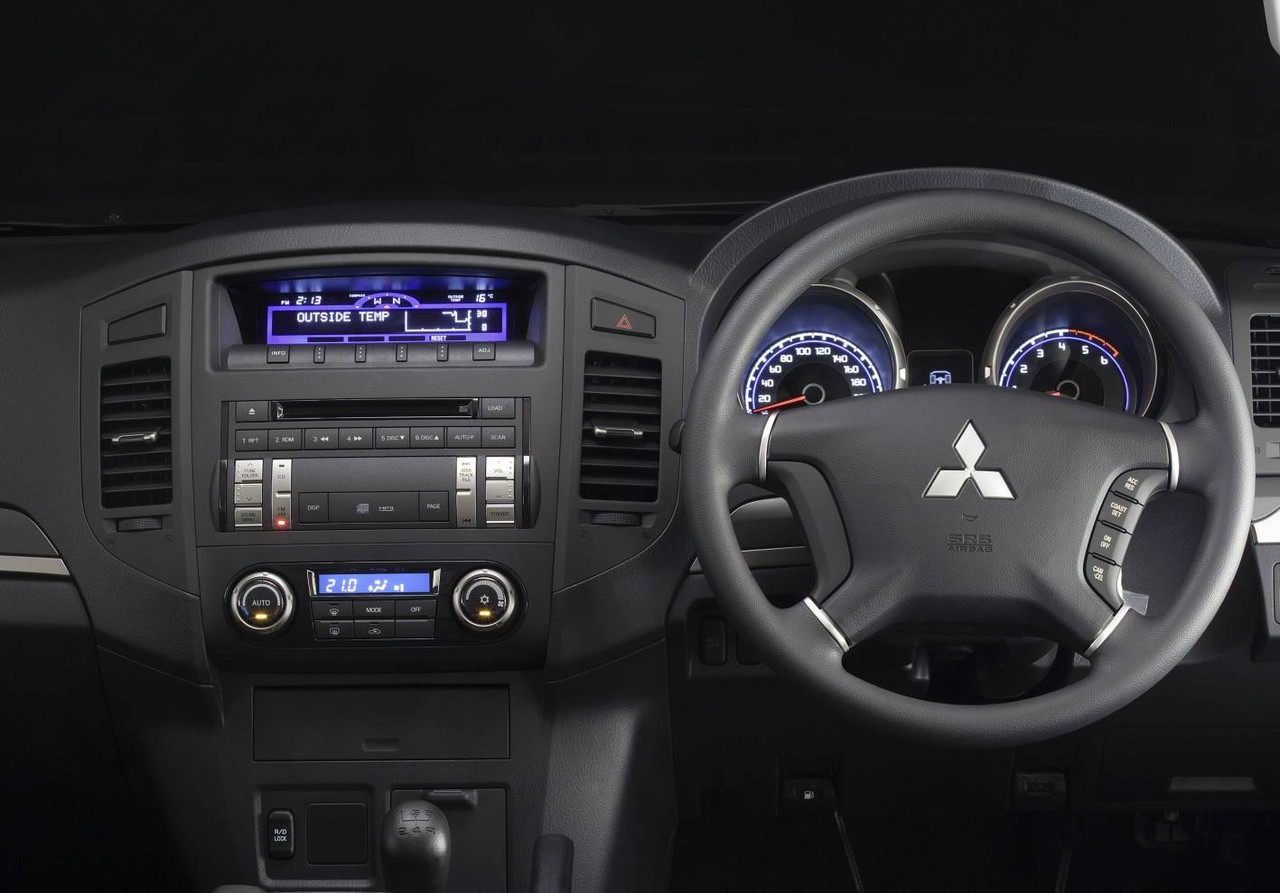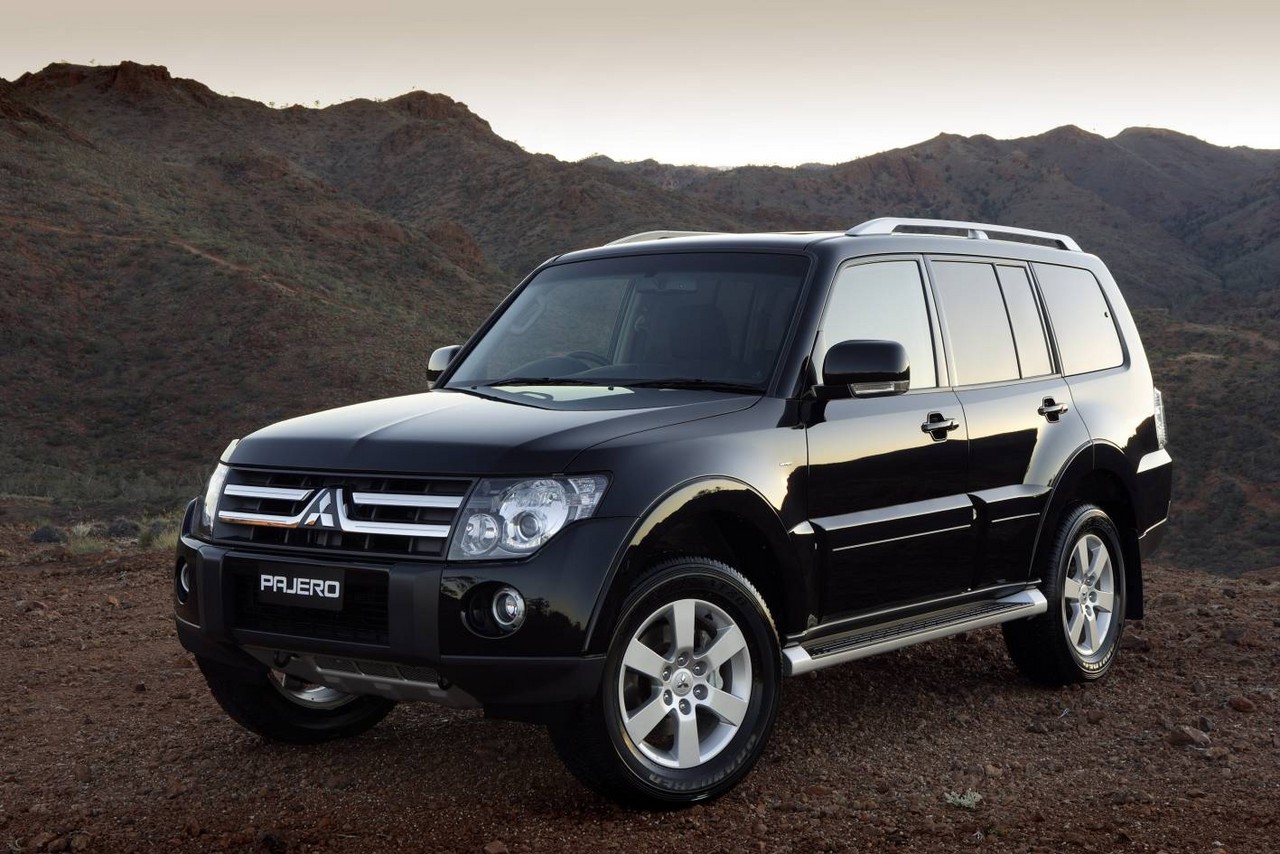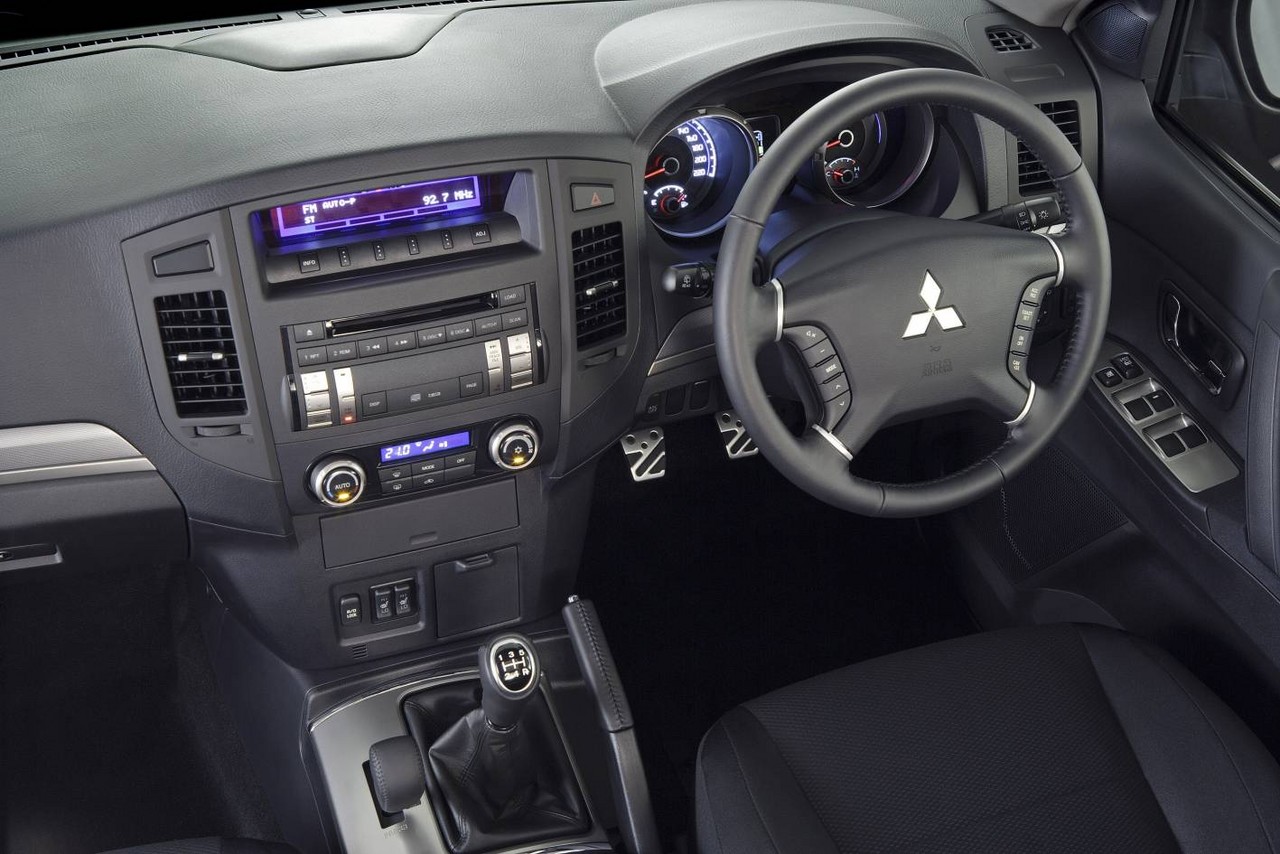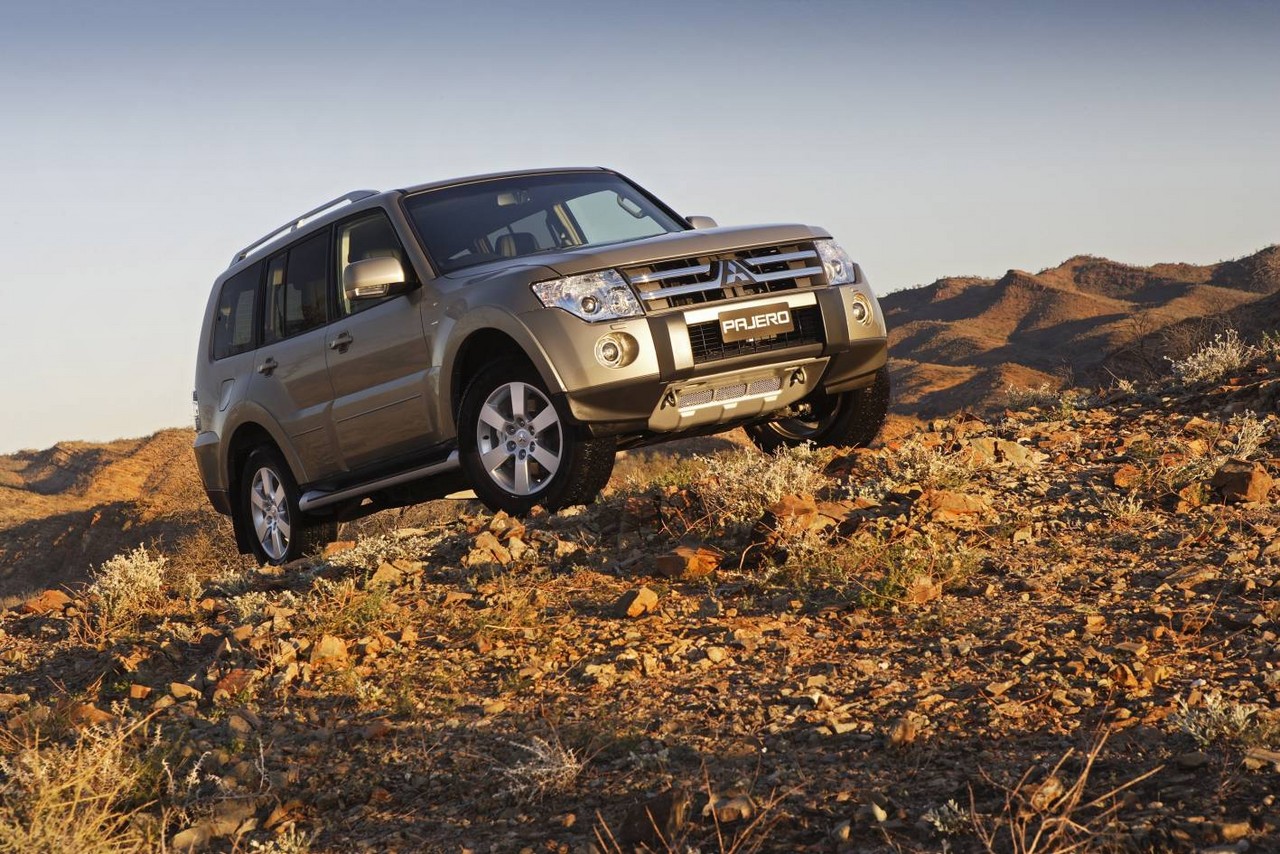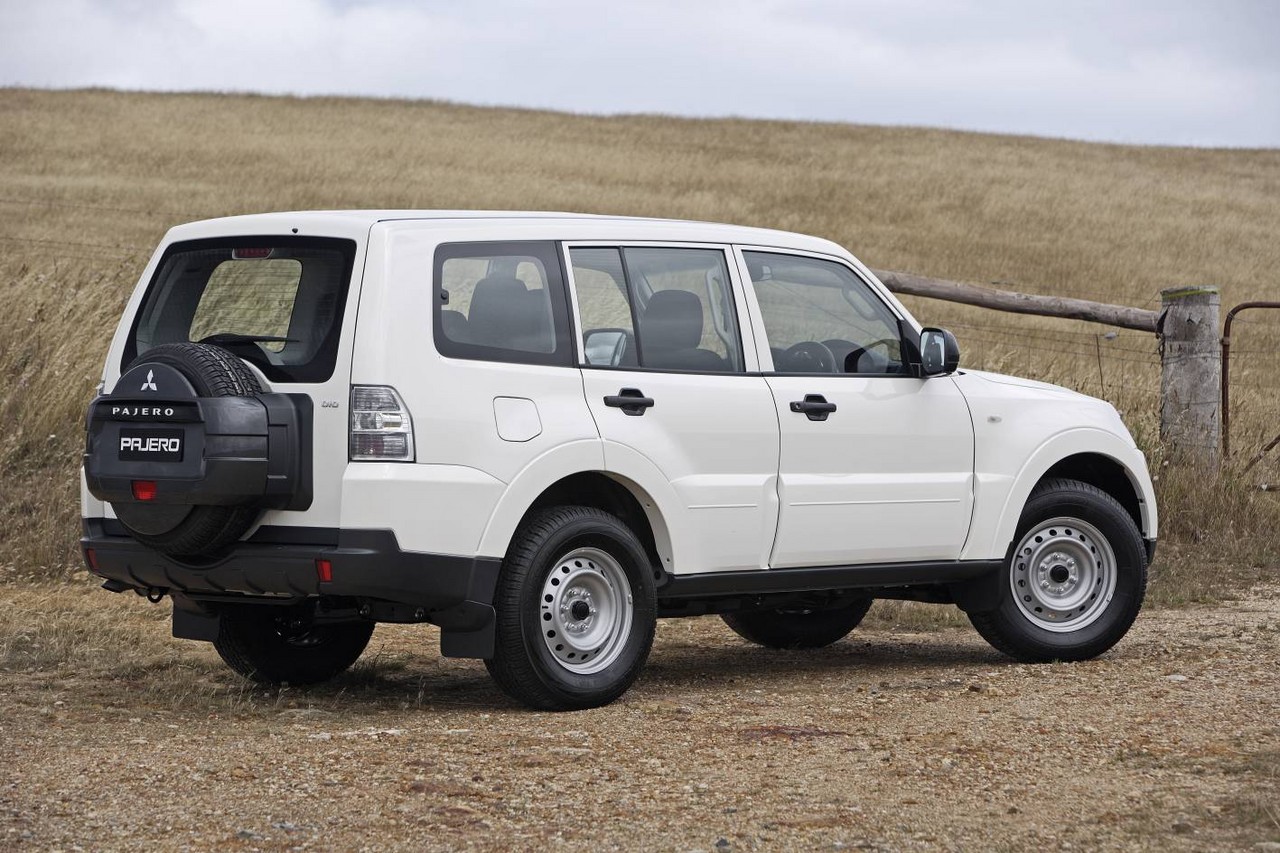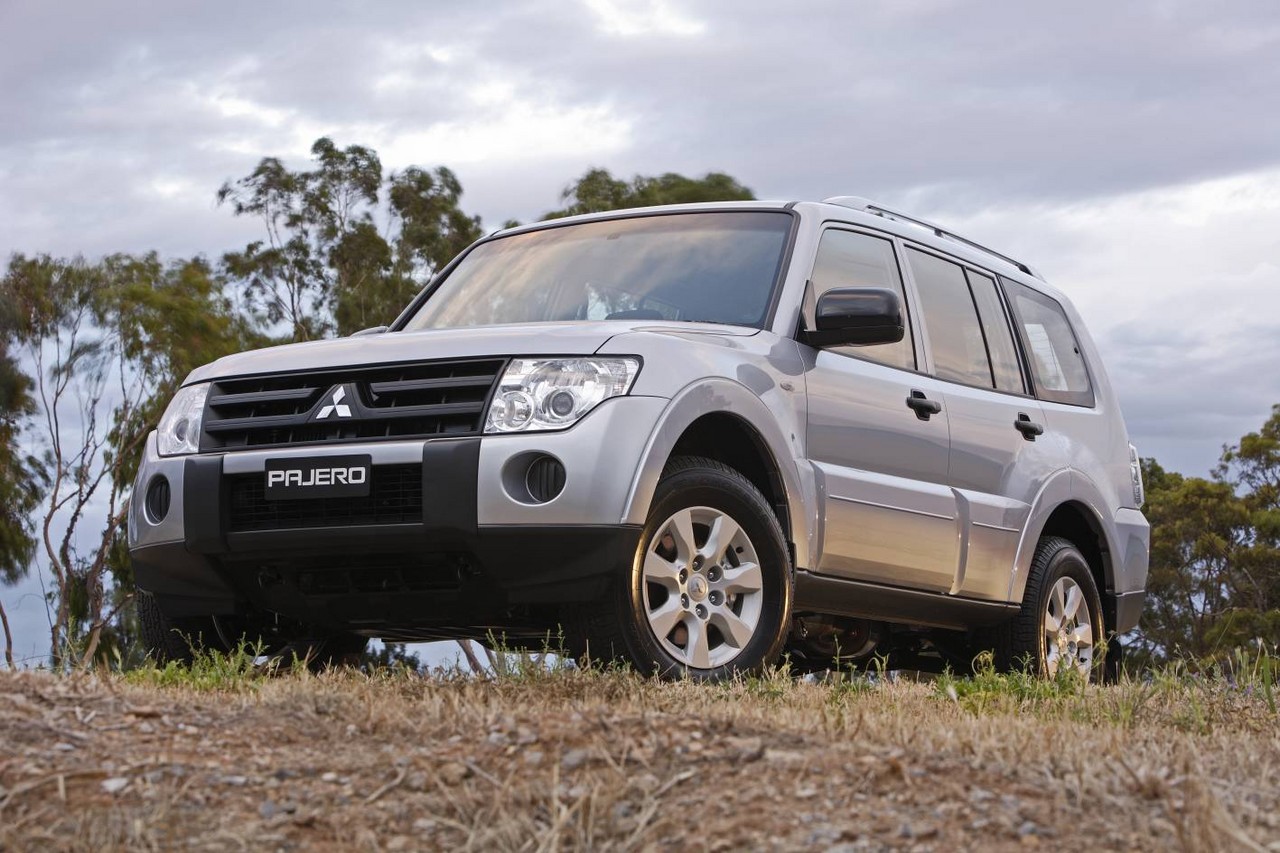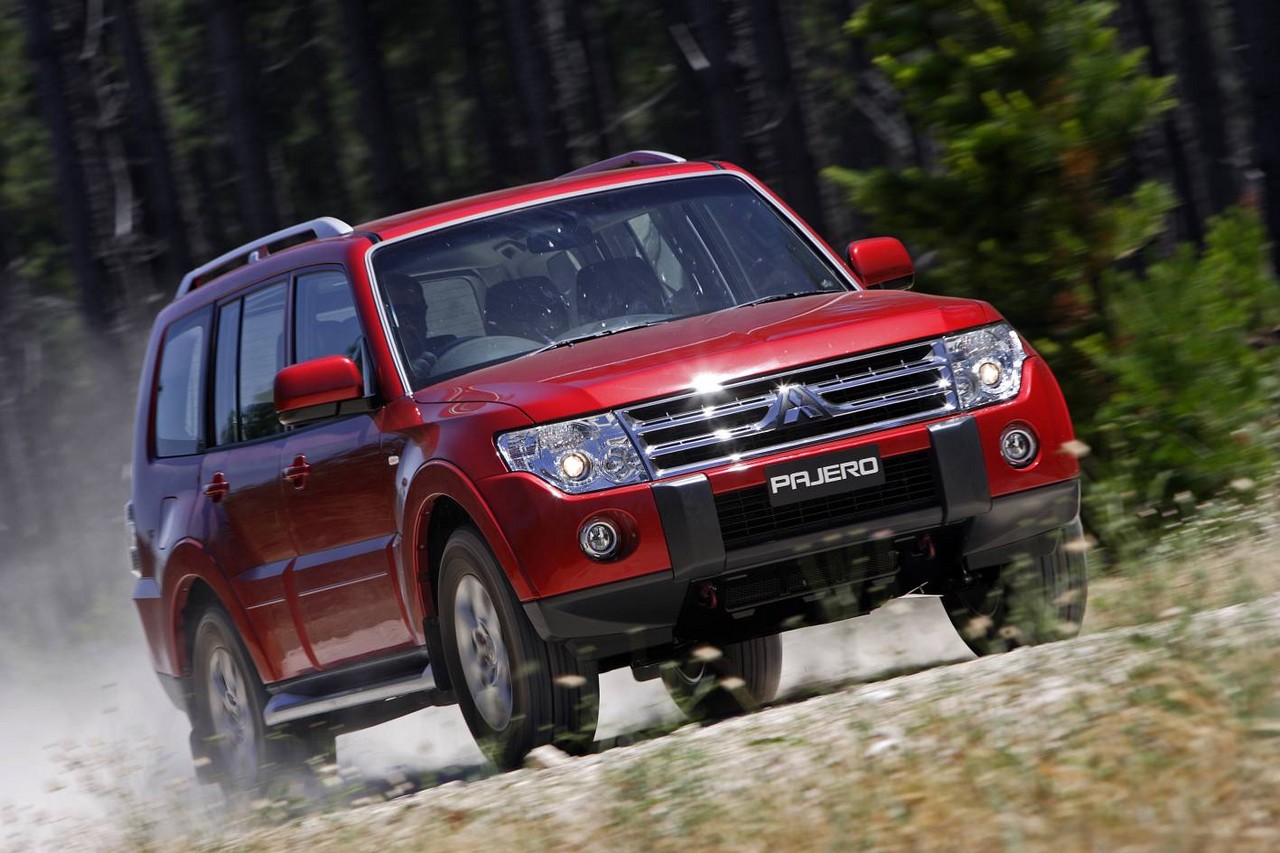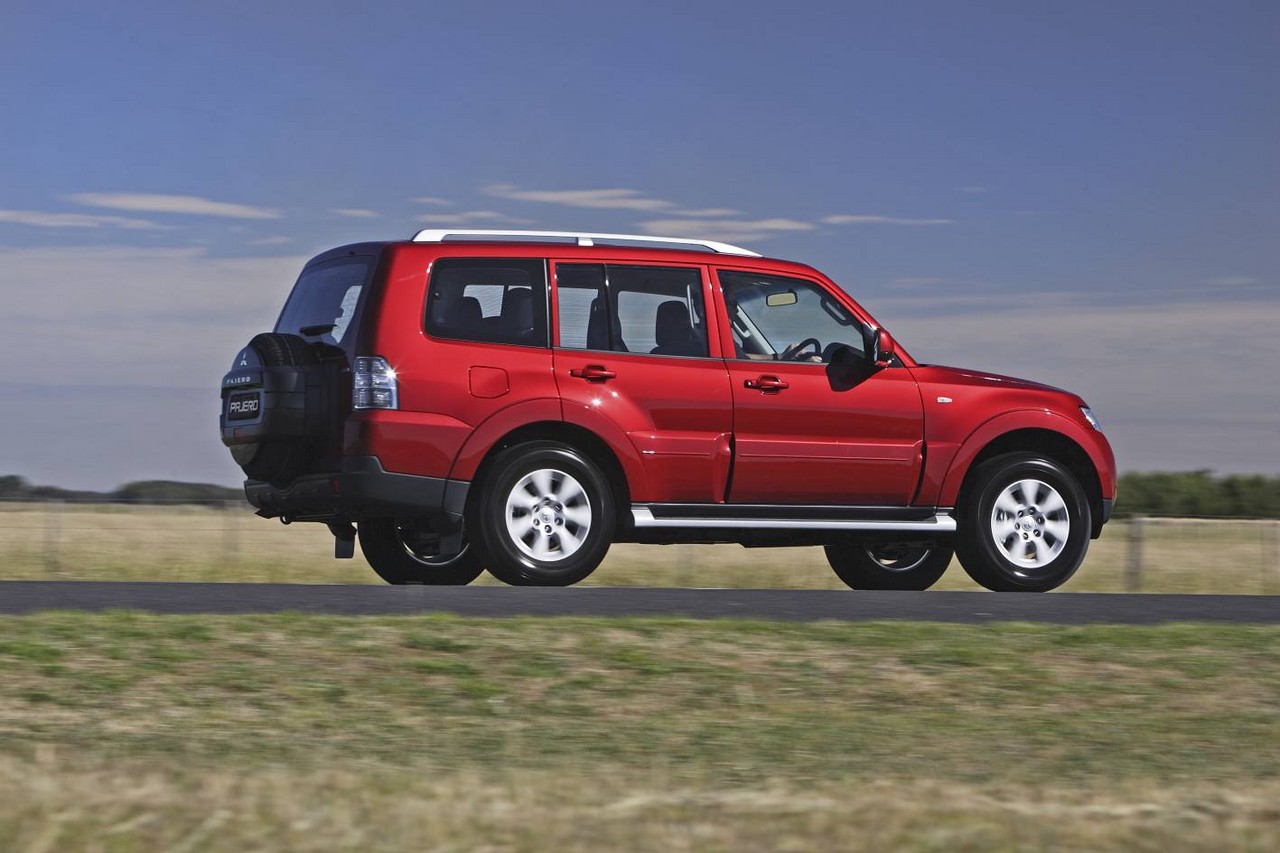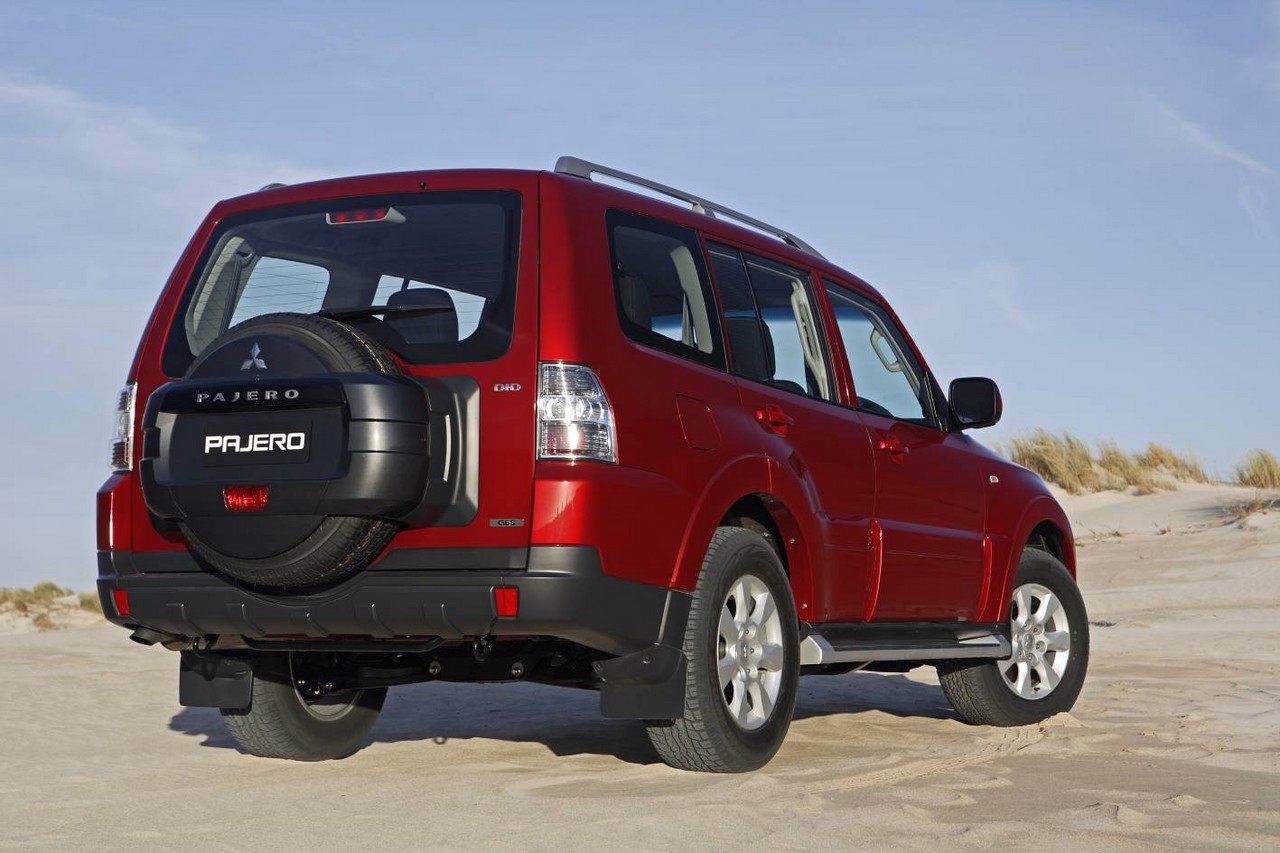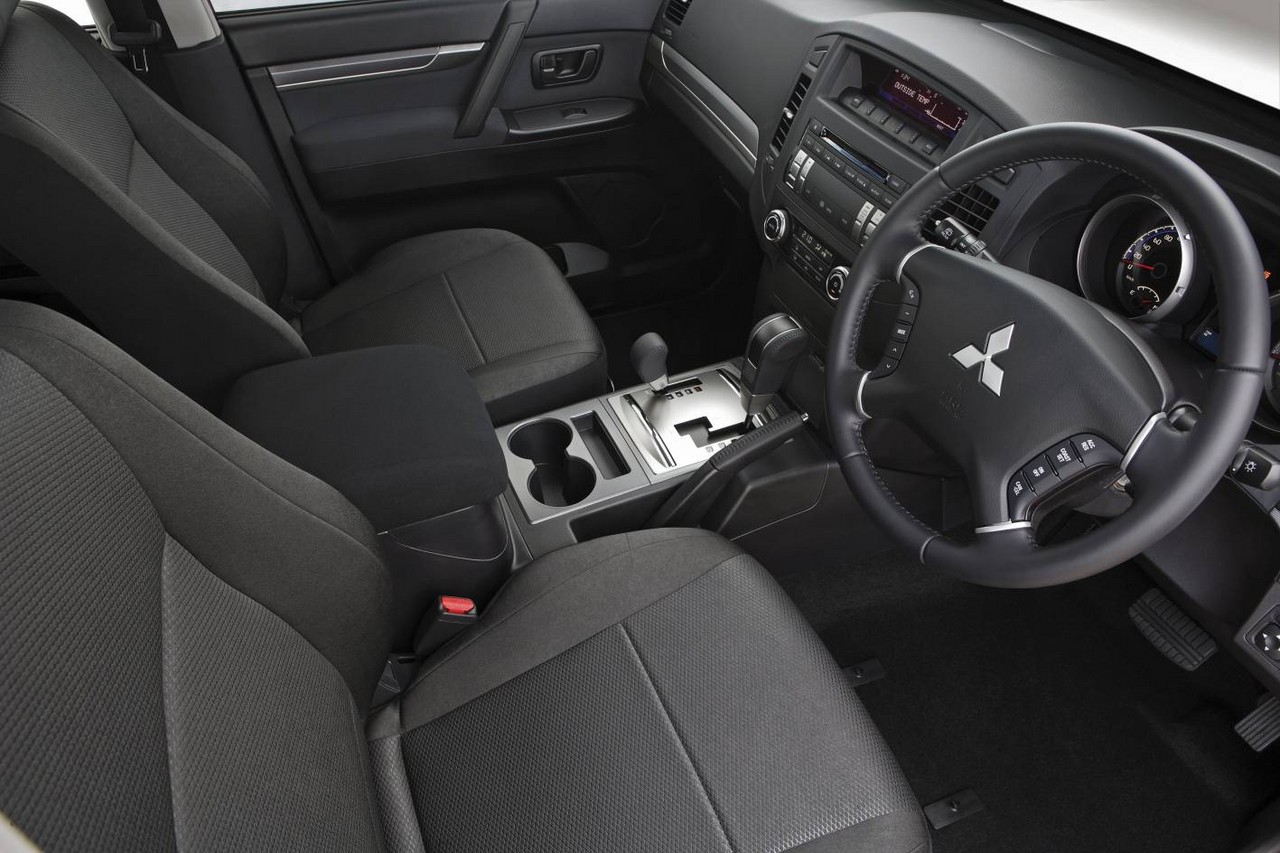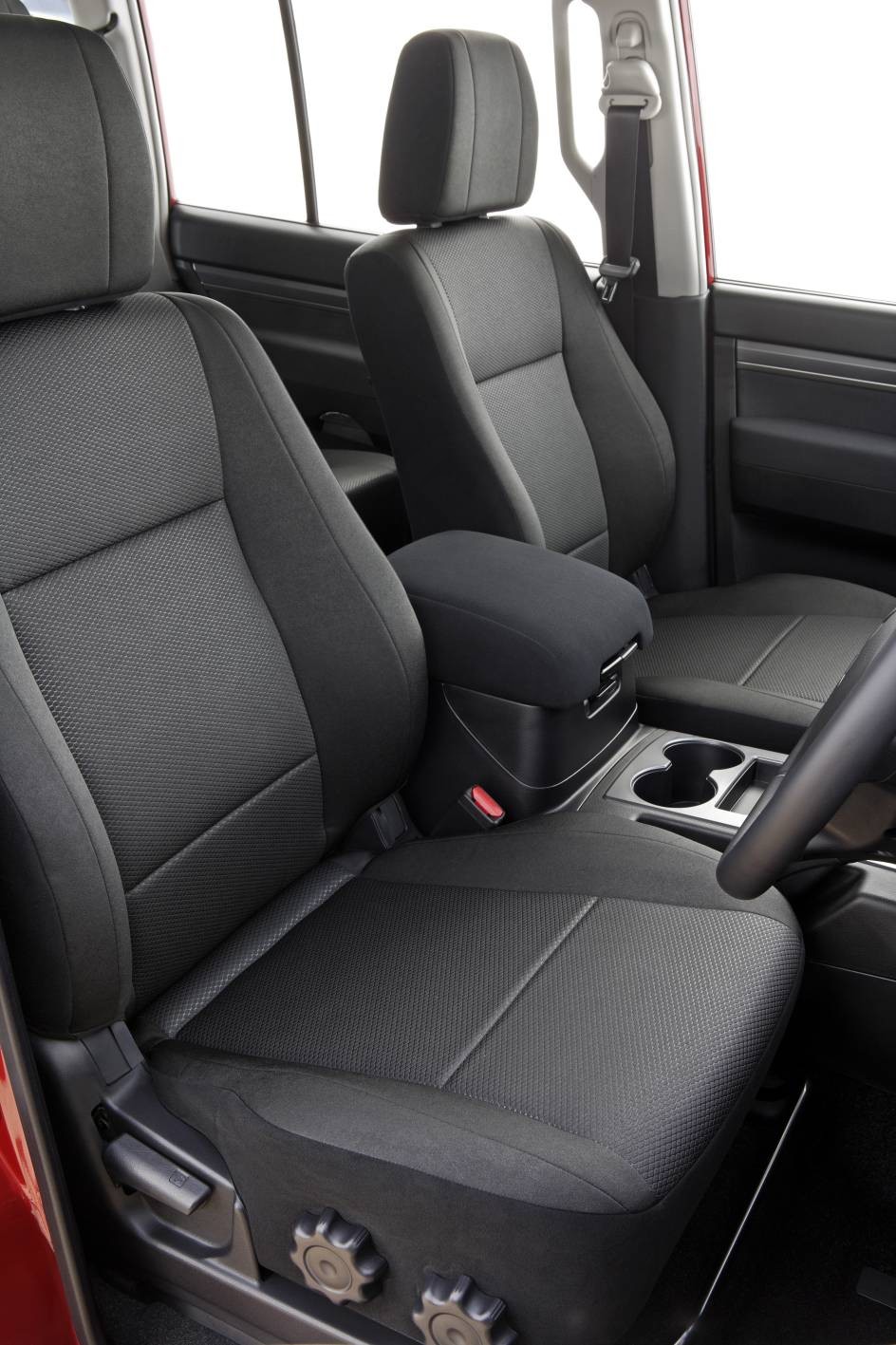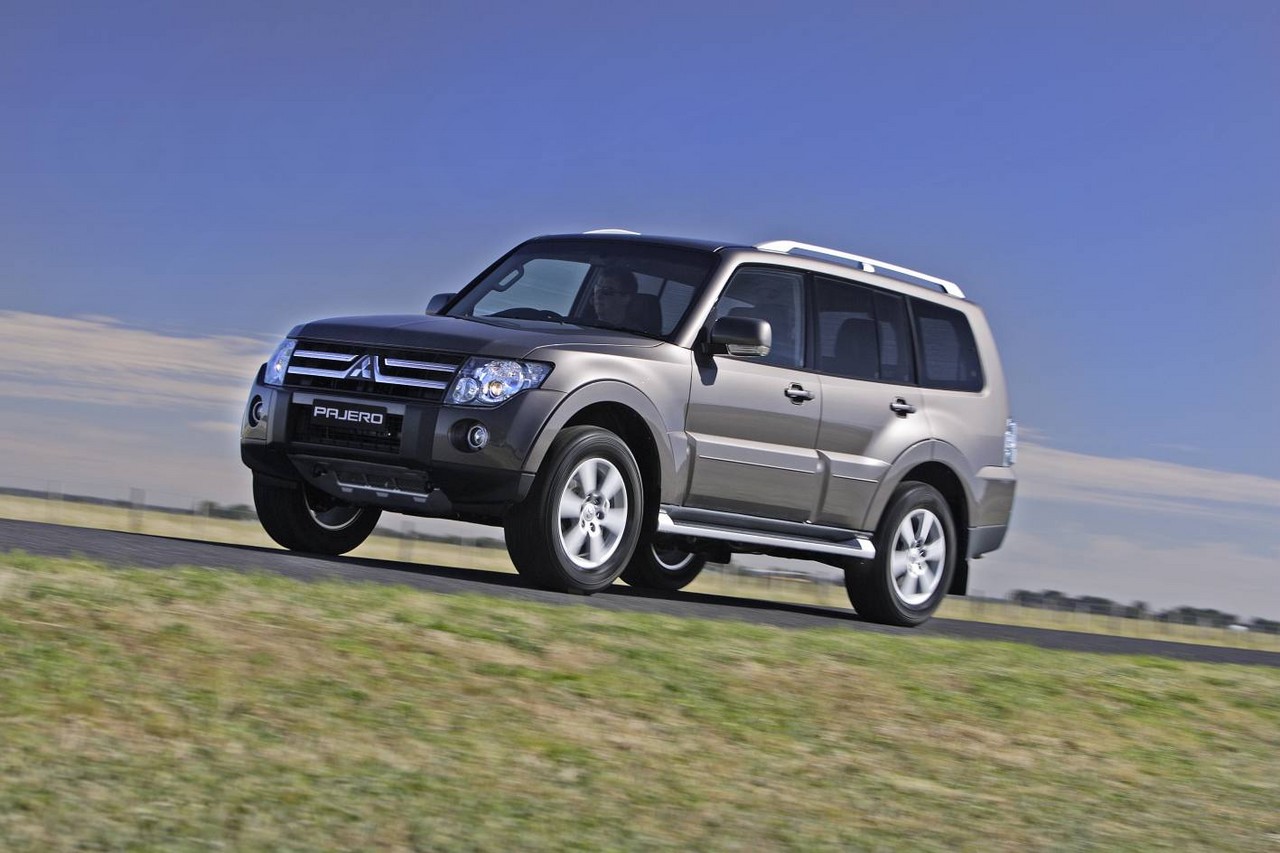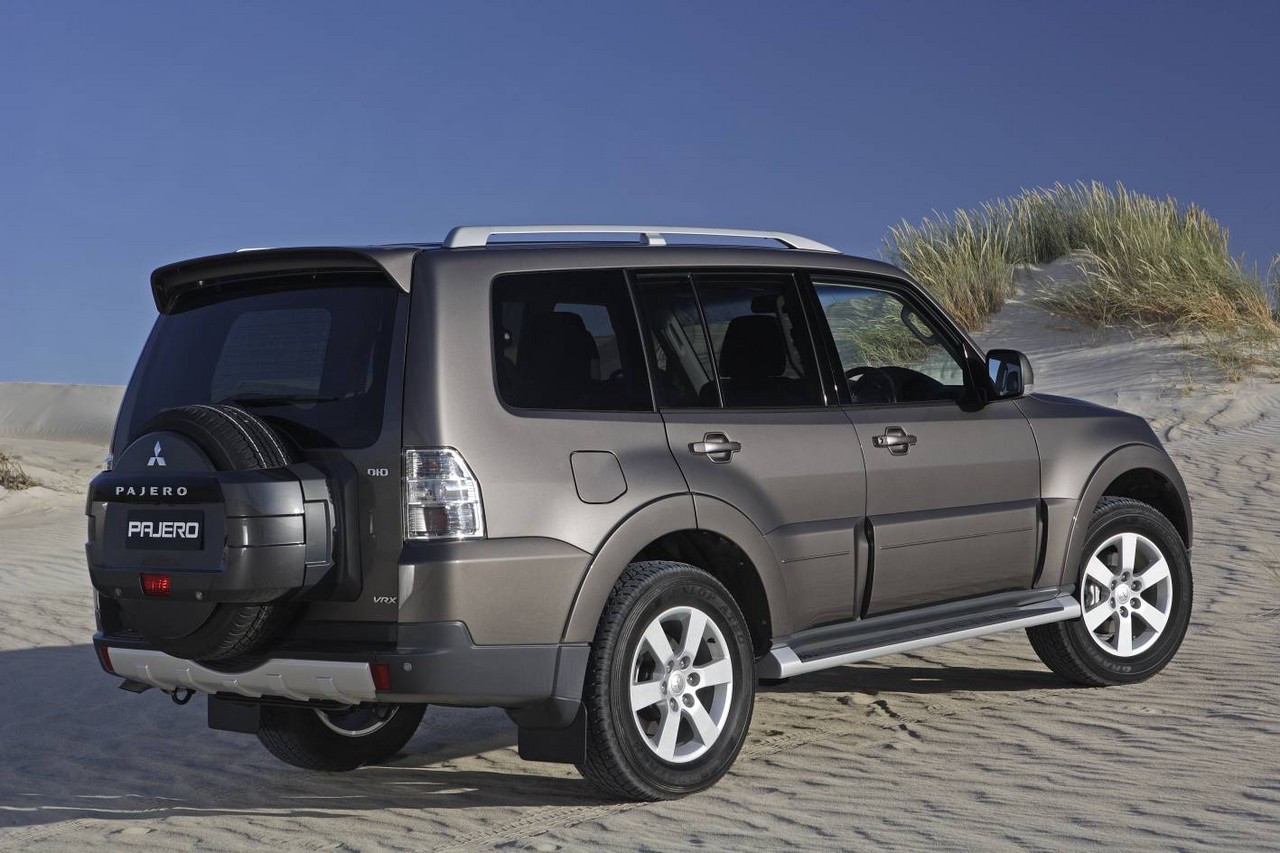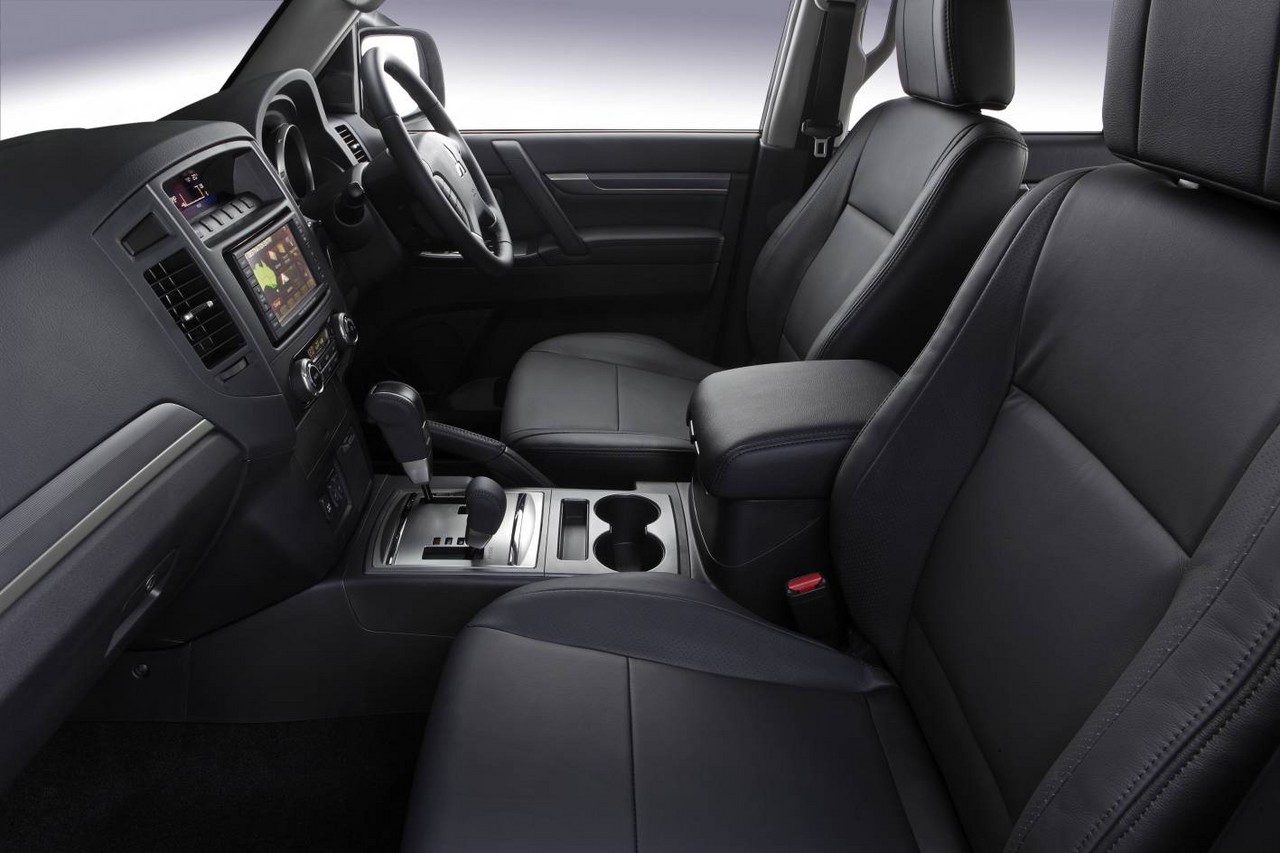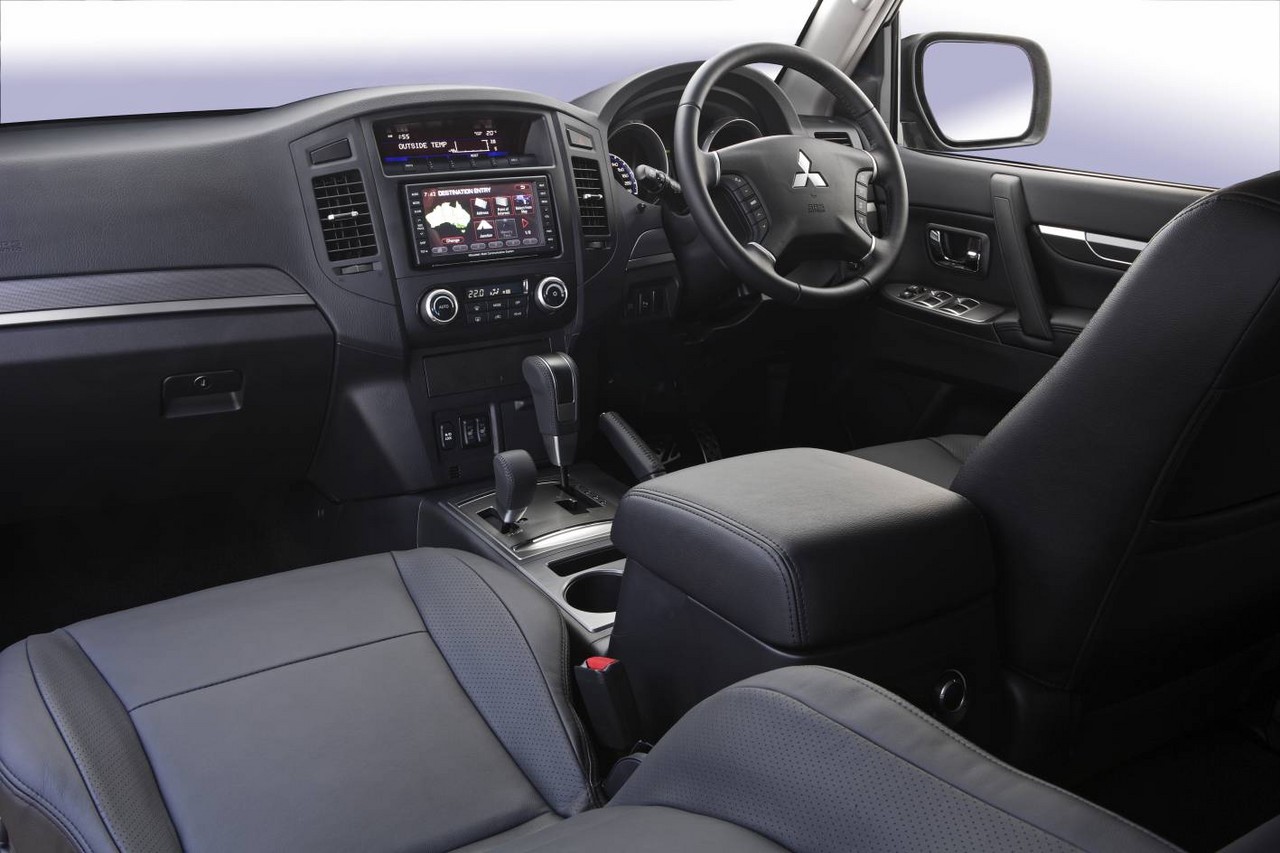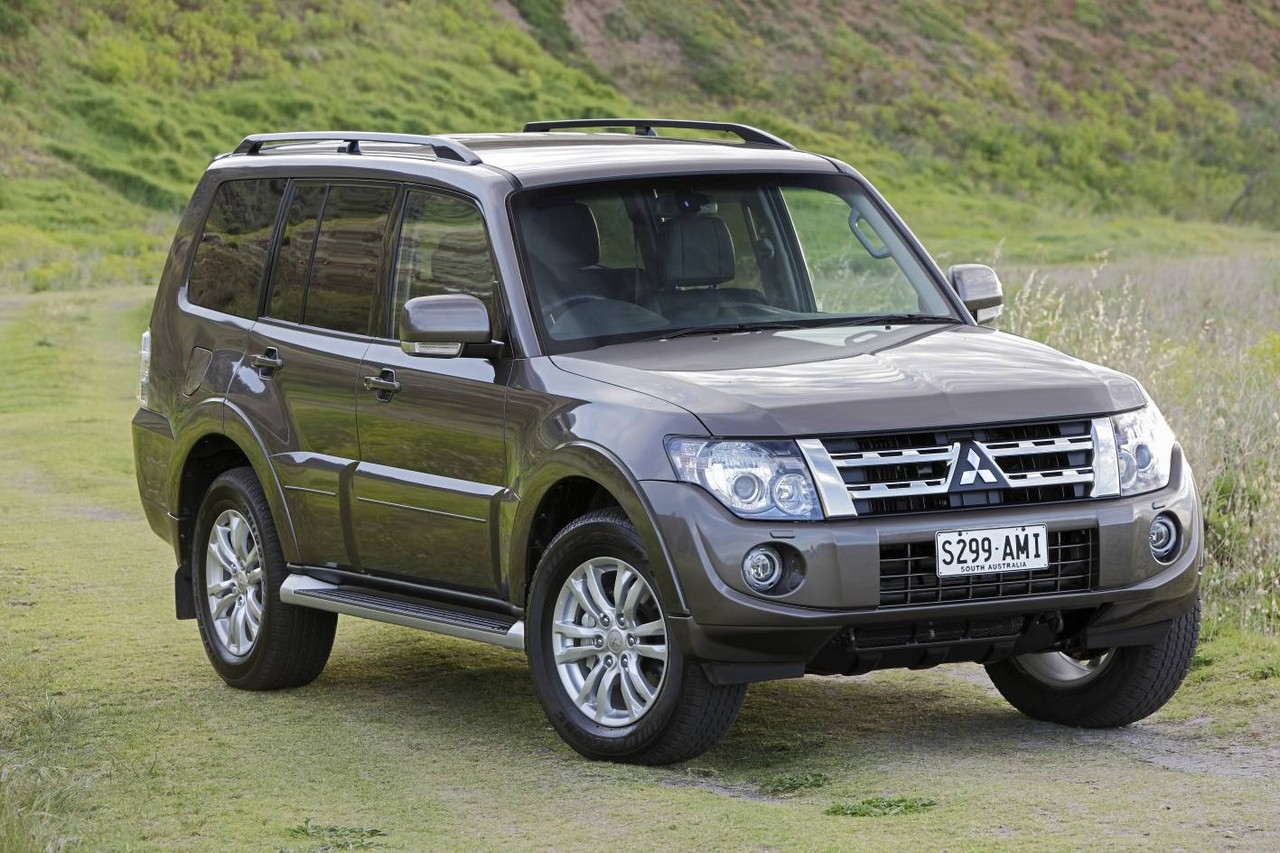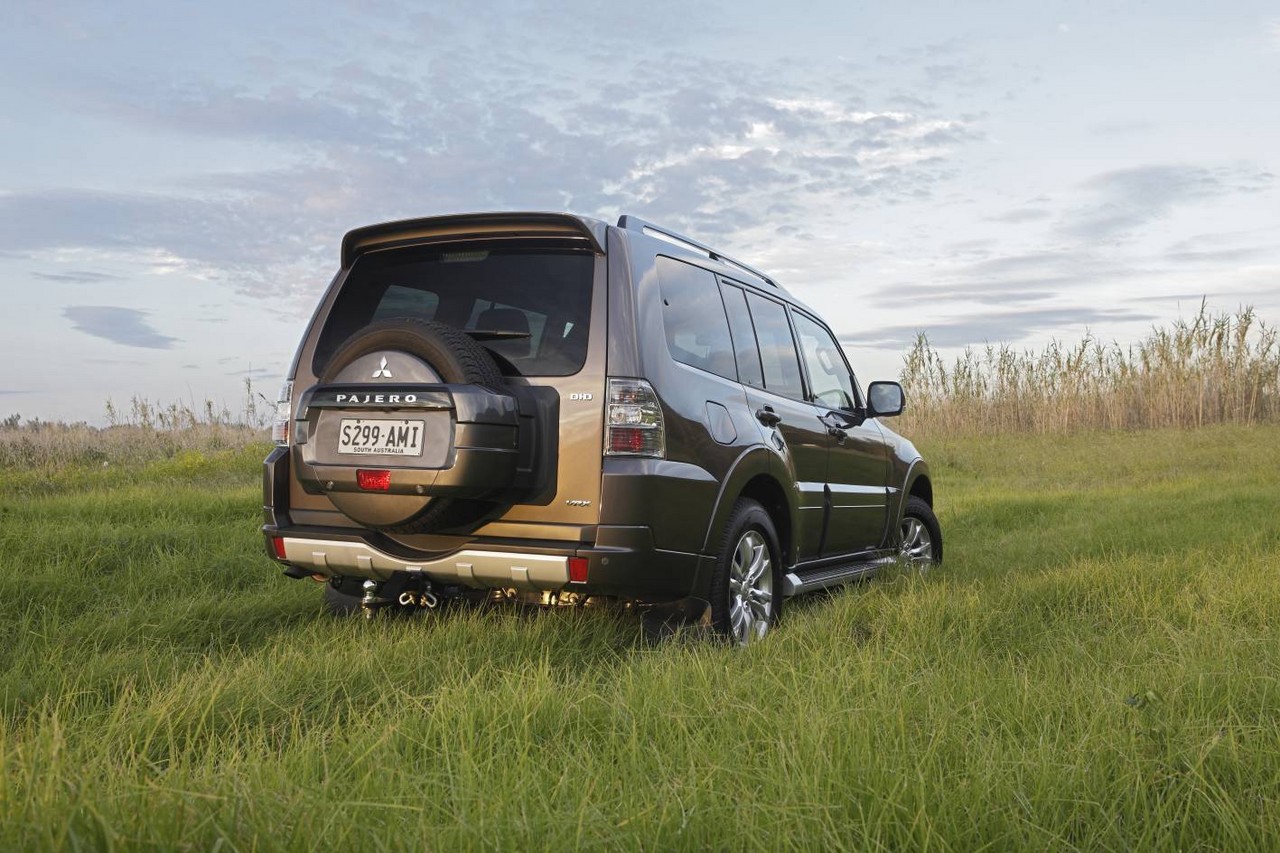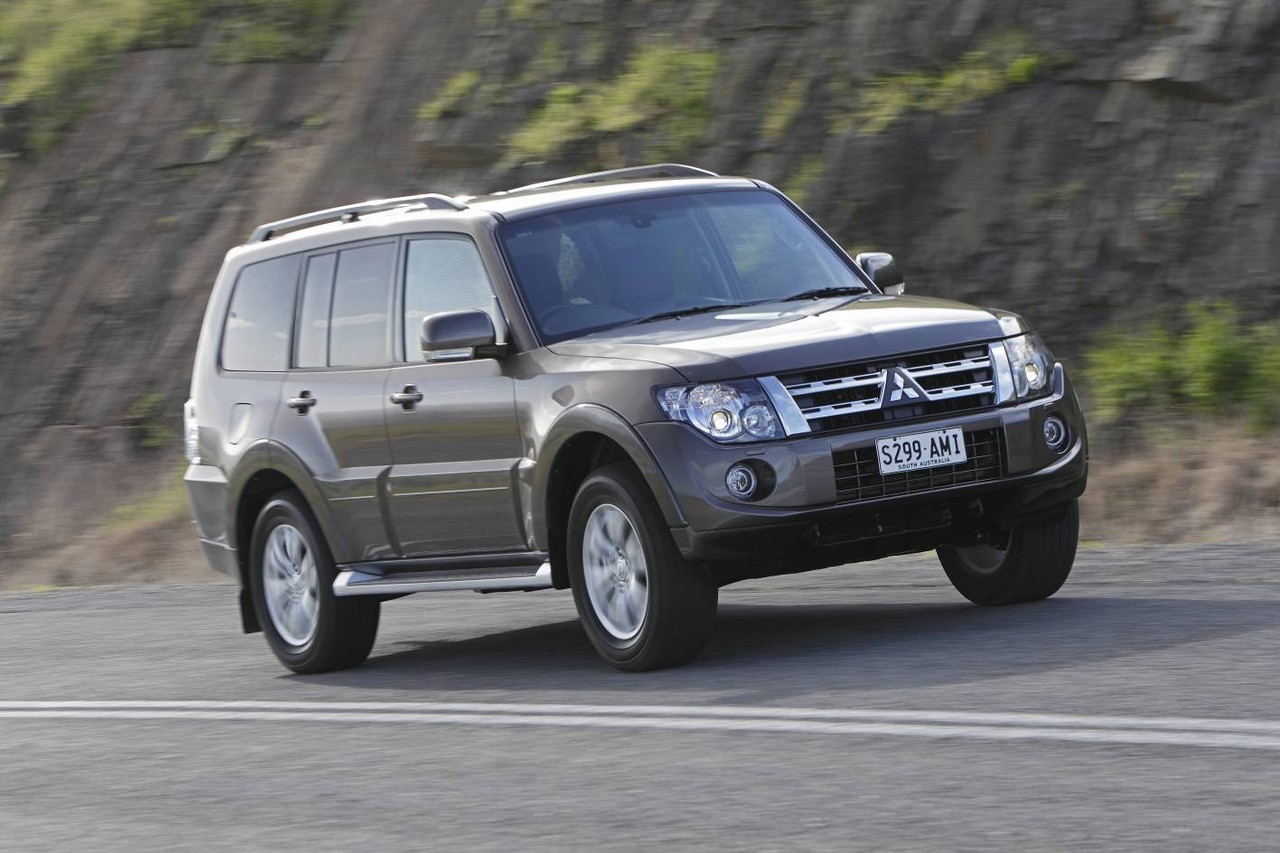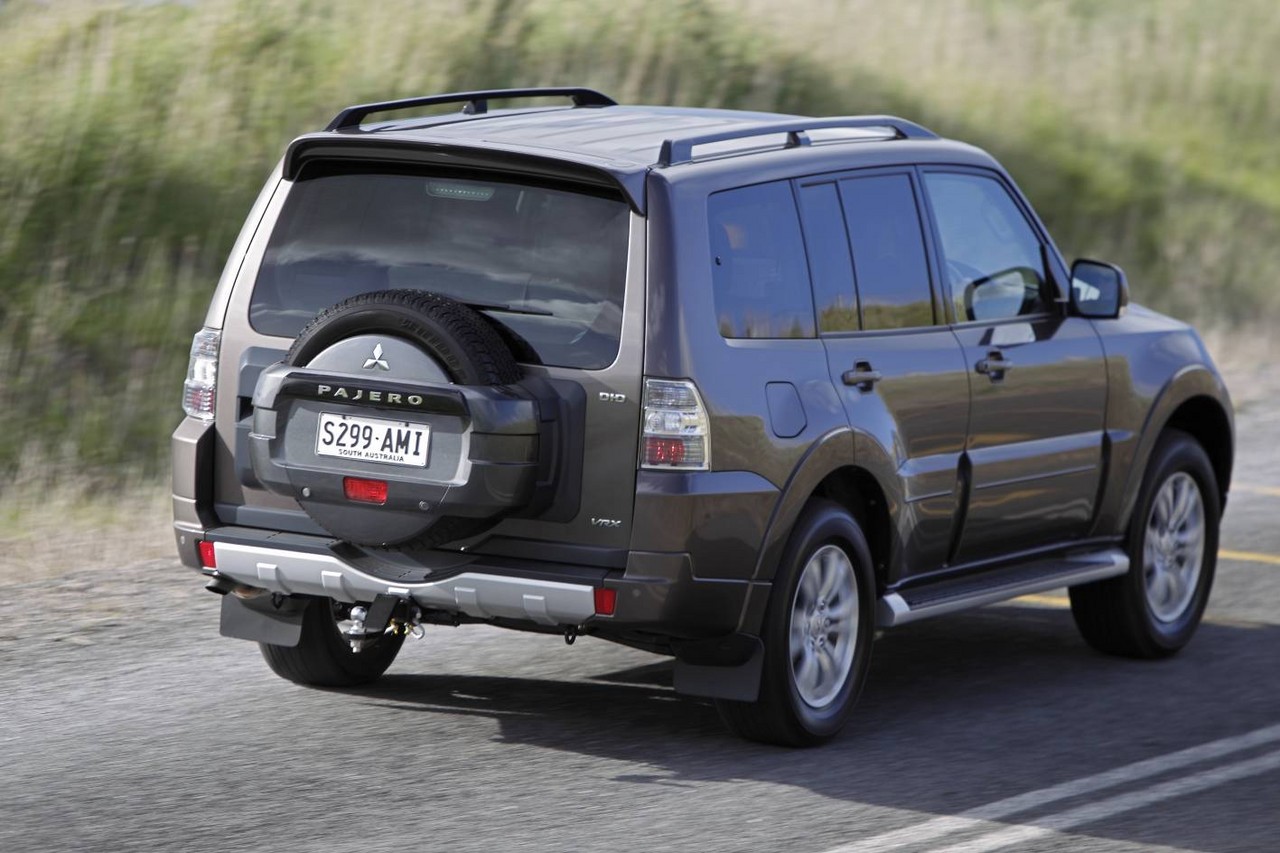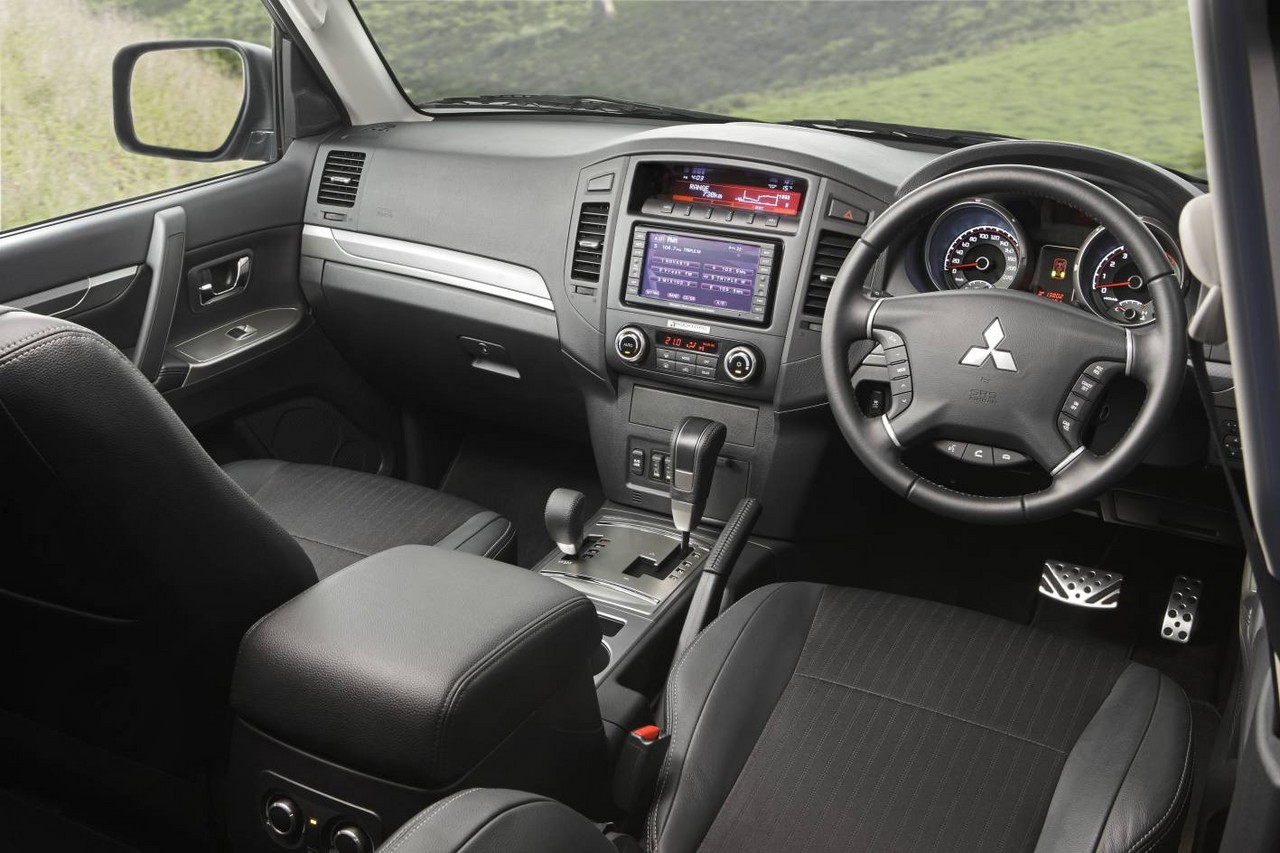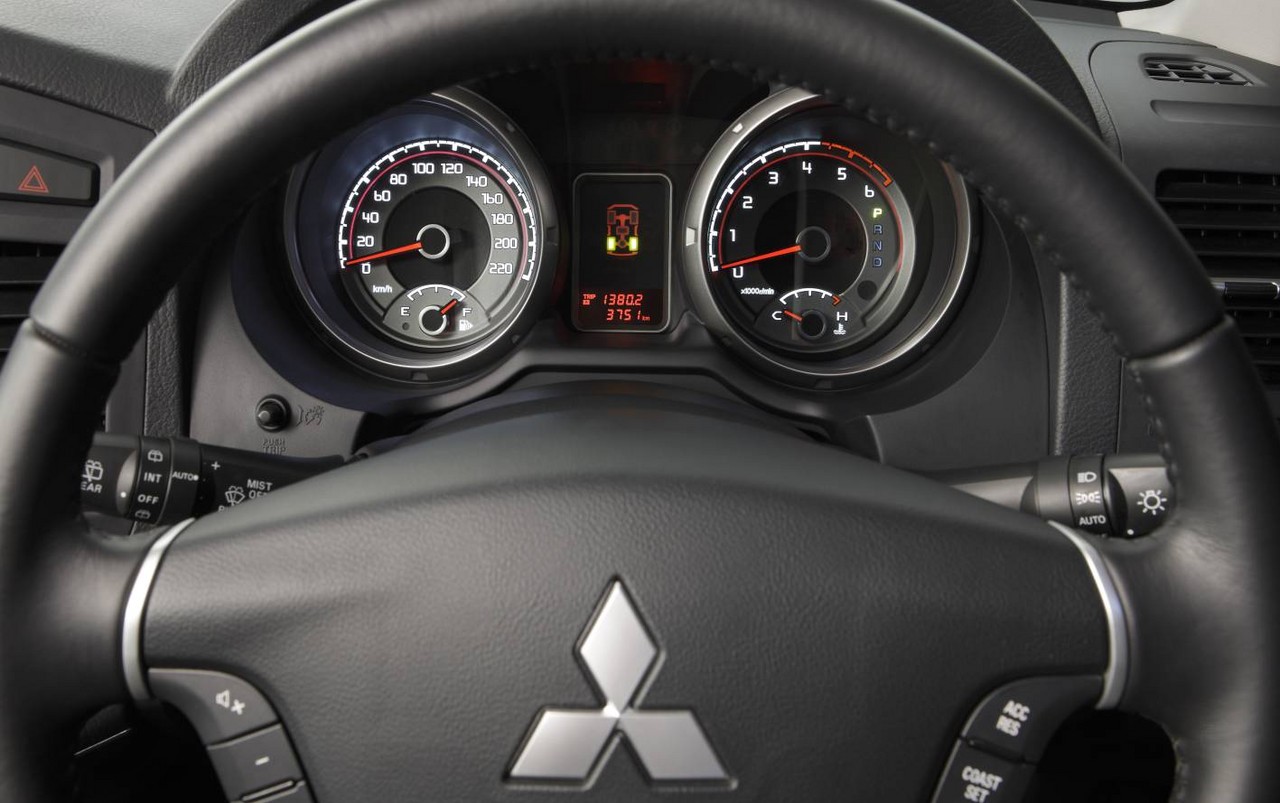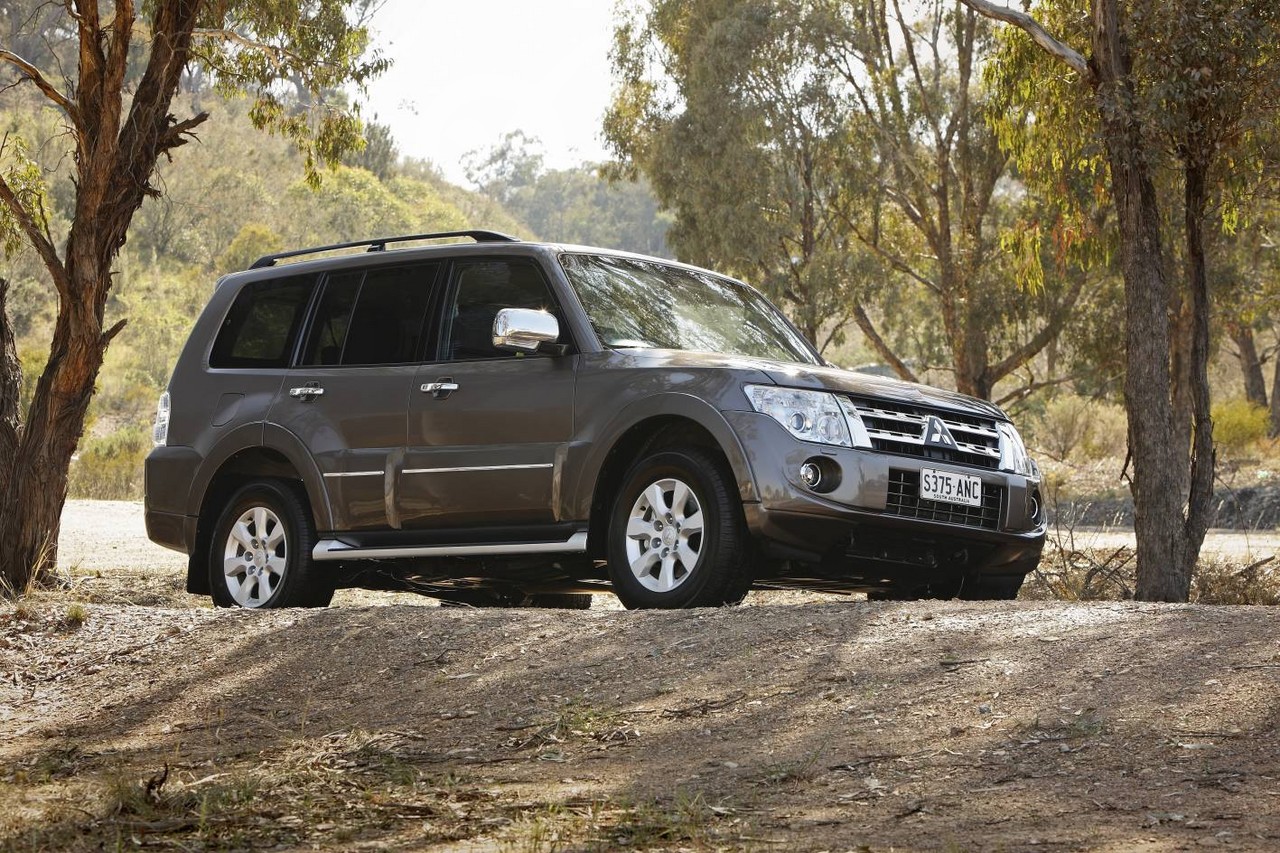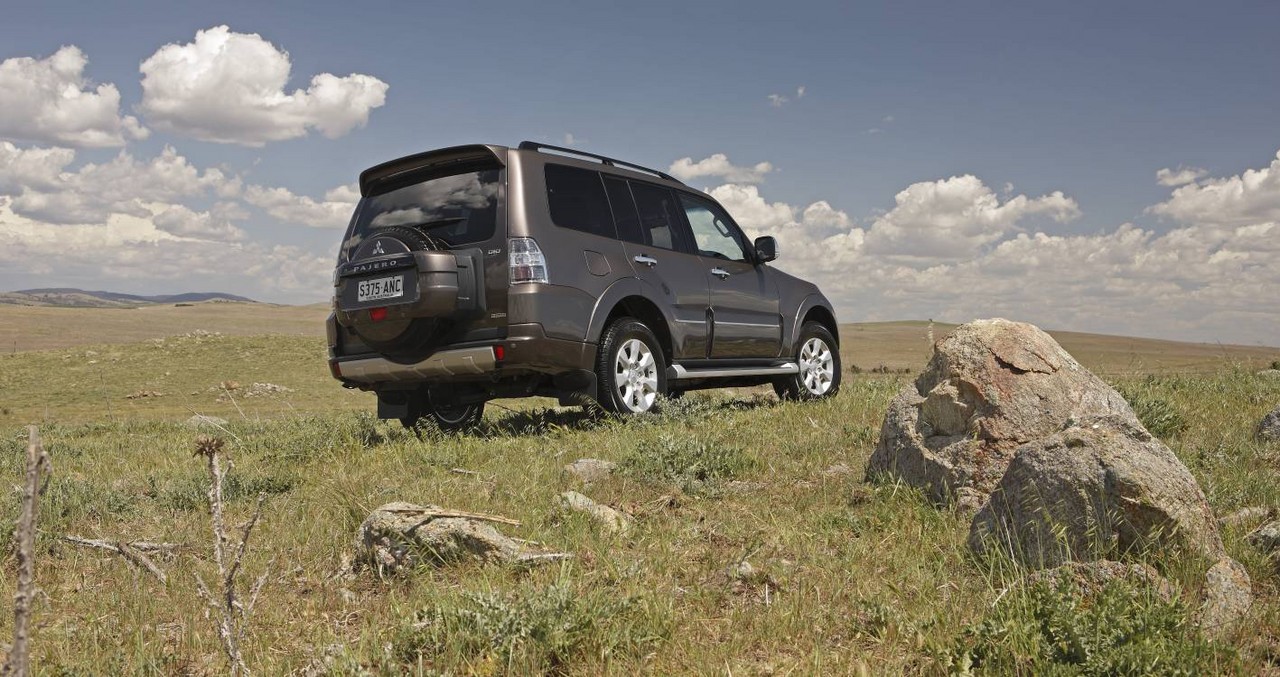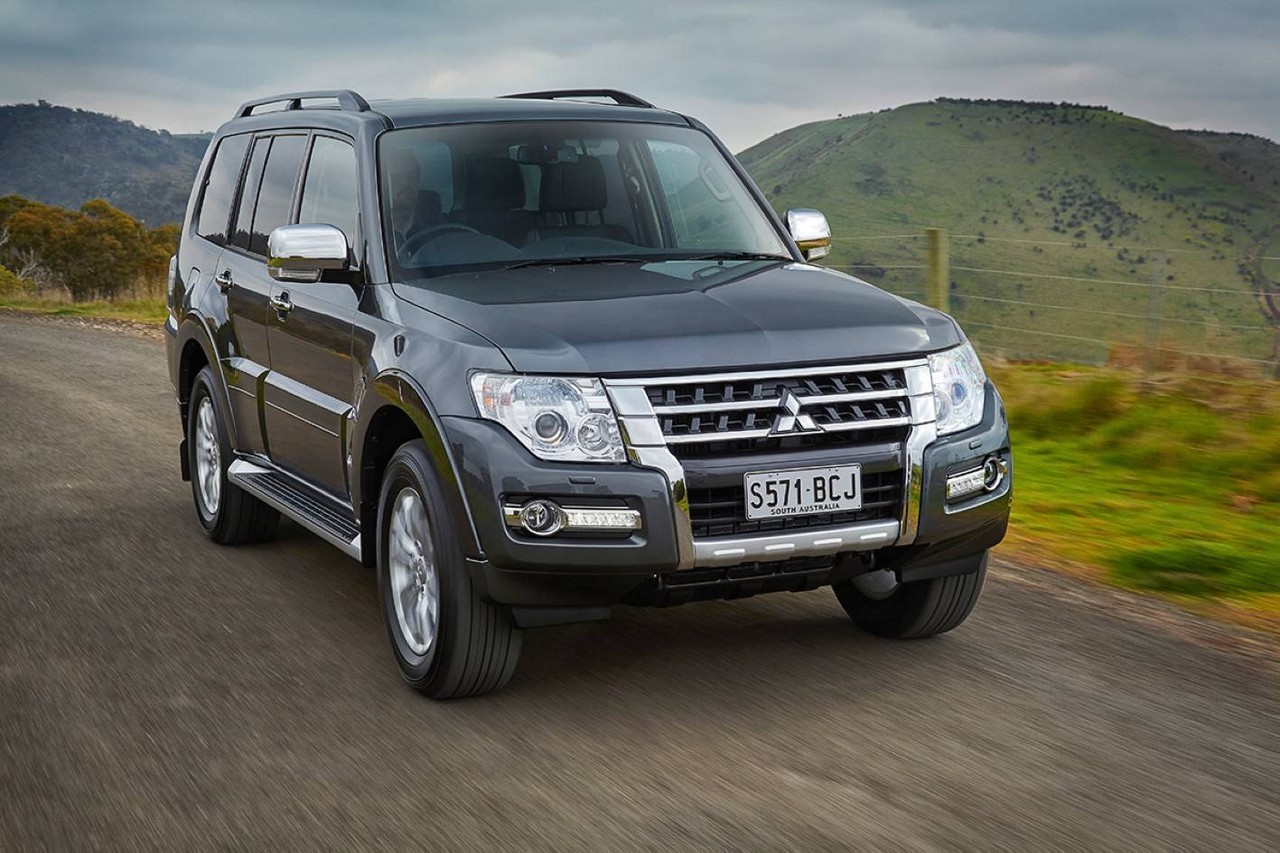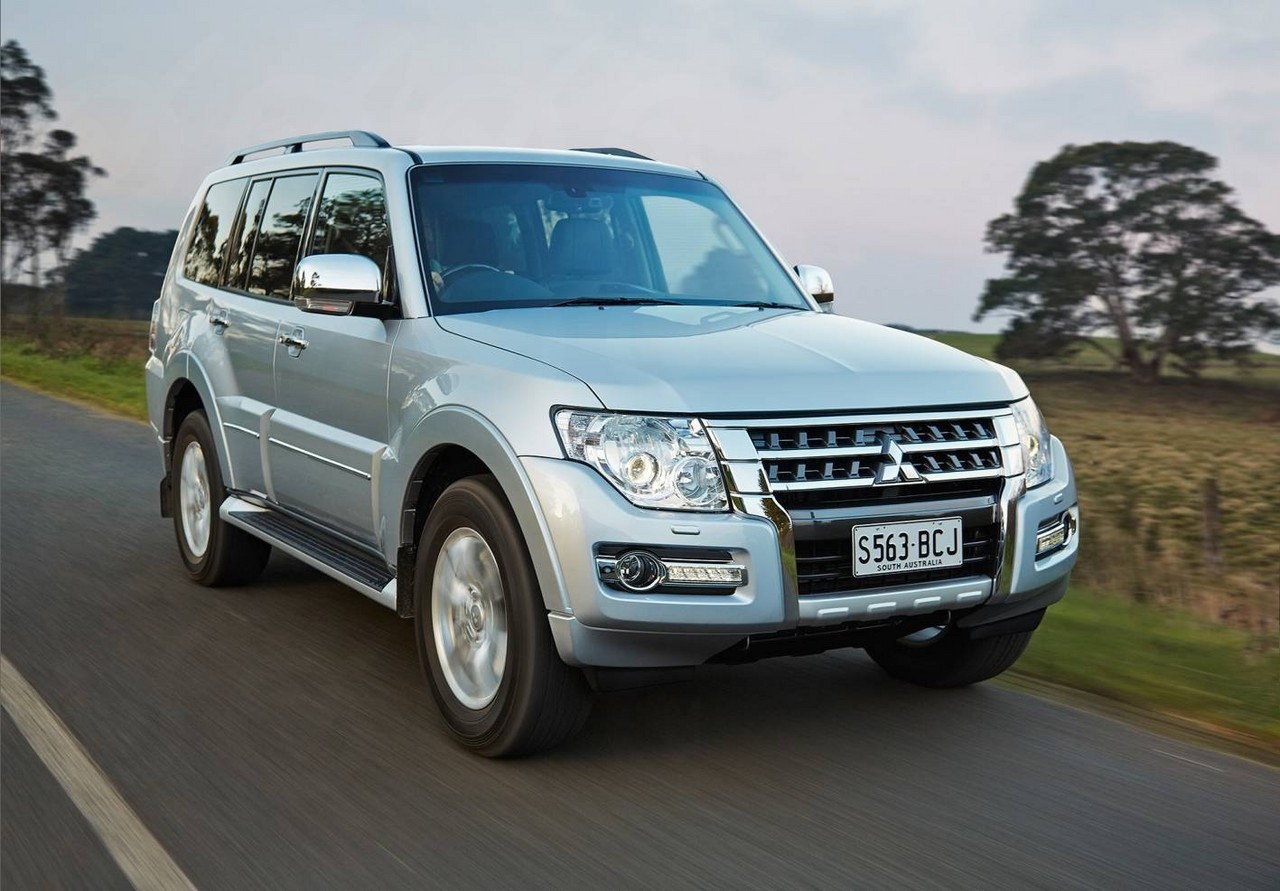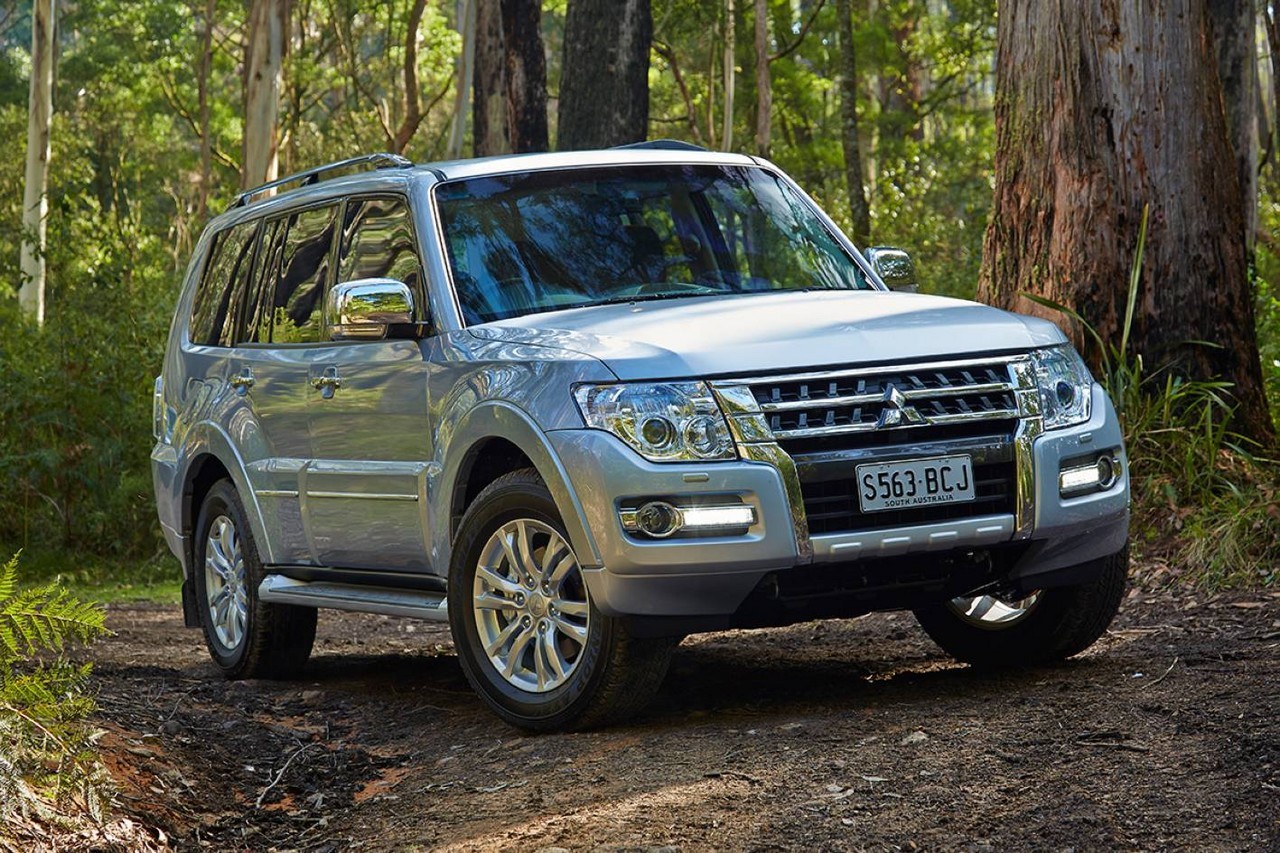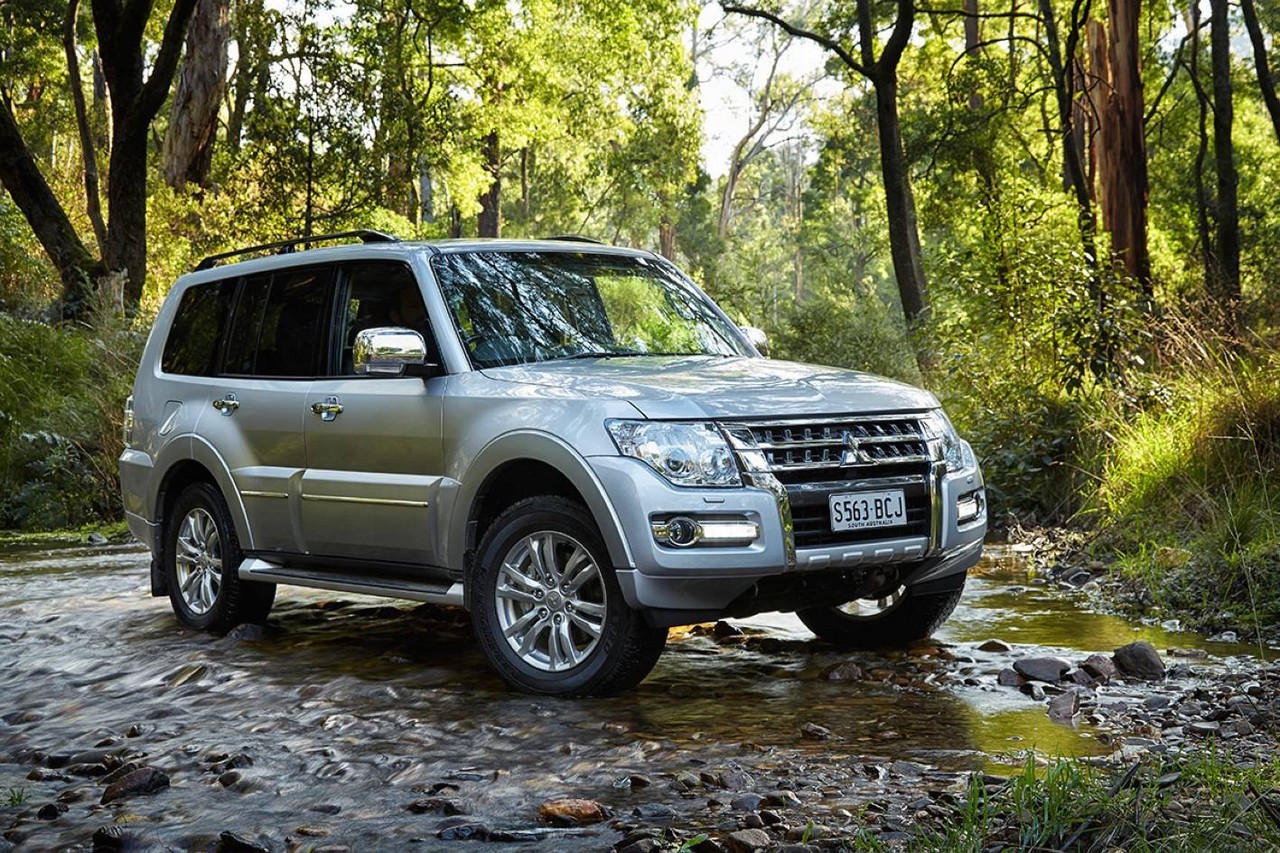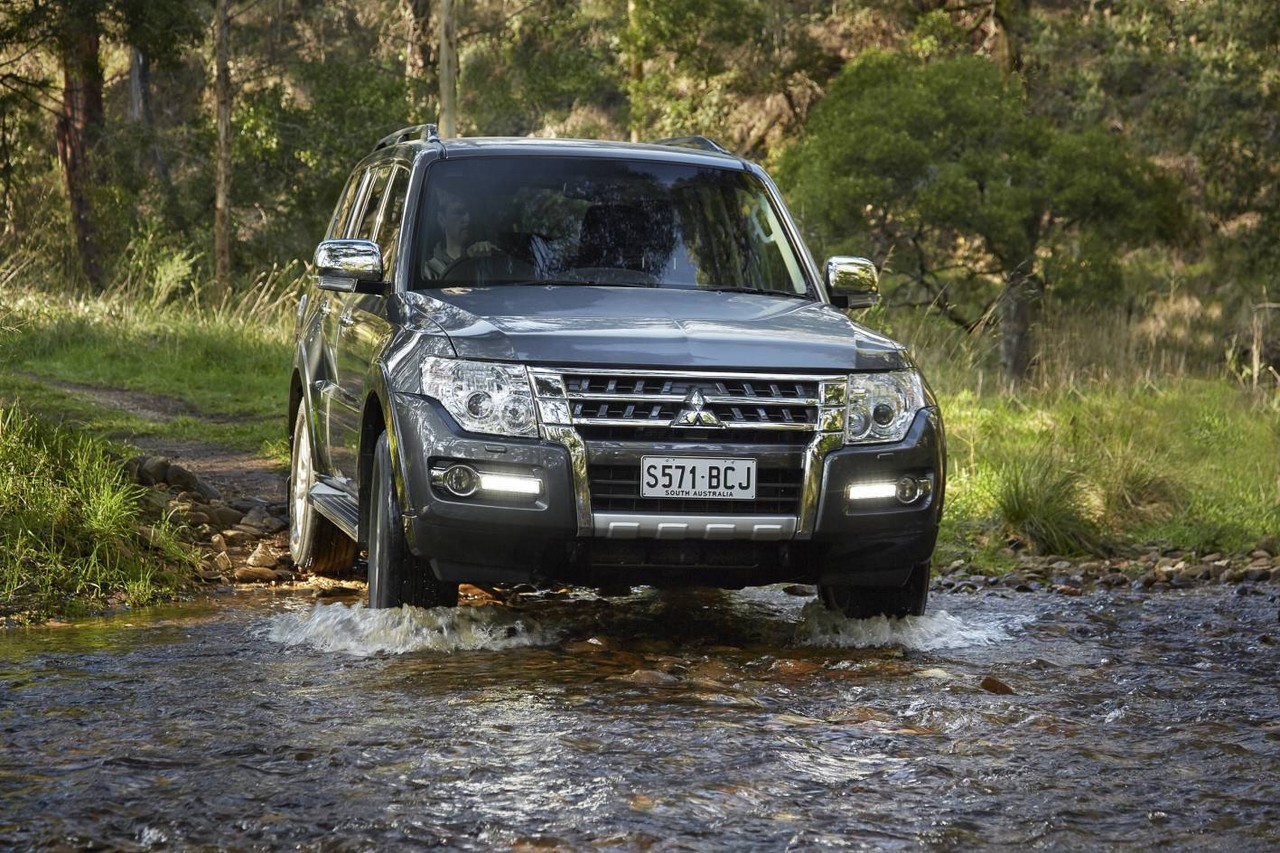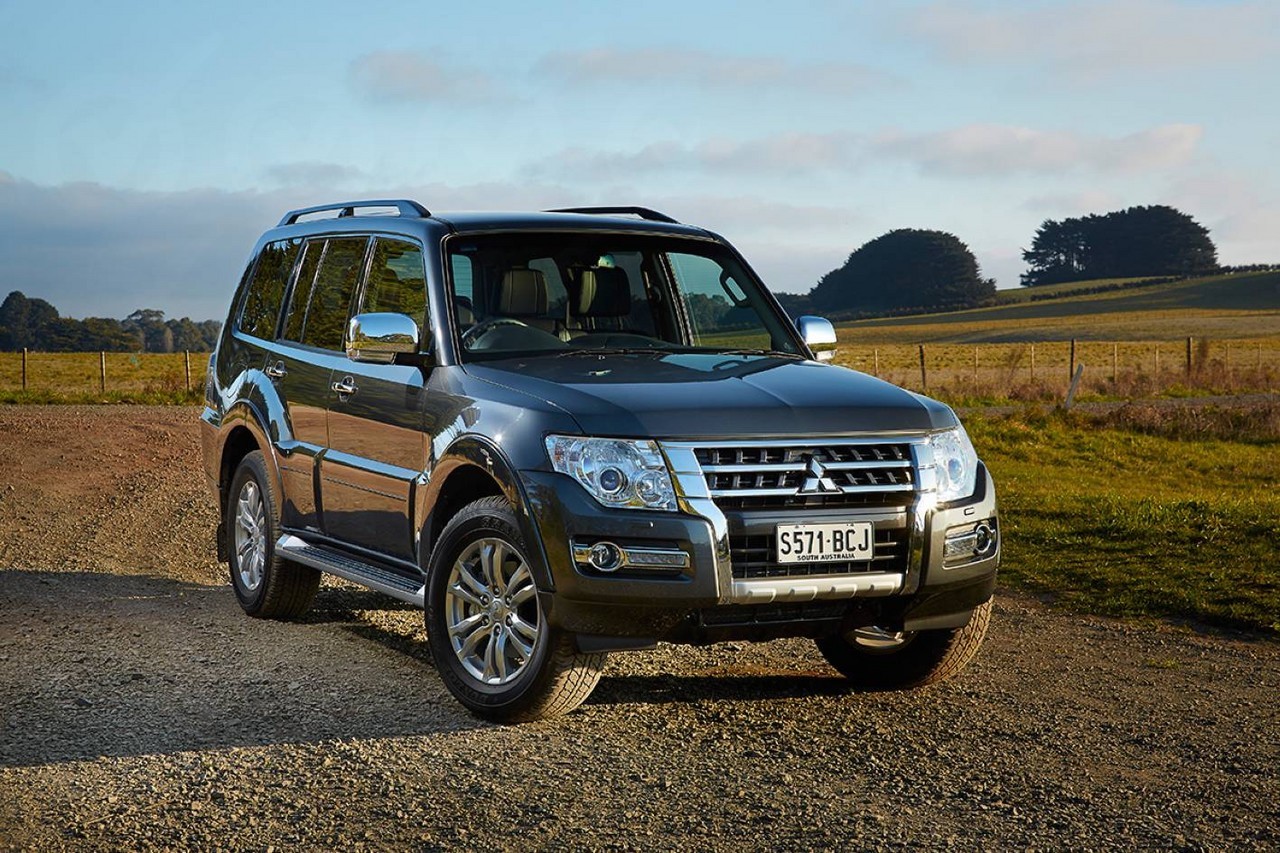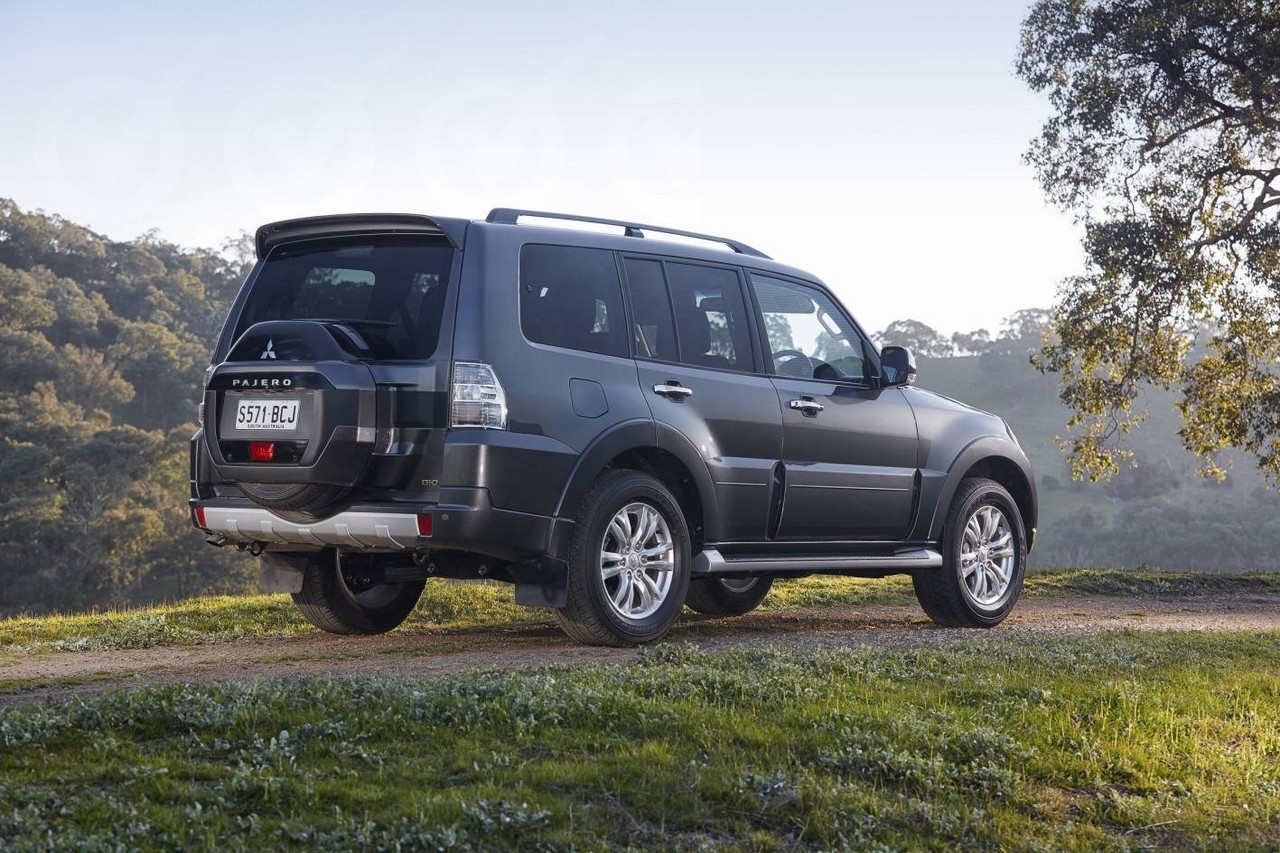
- Responsive 3.2-litre turbo-diesel engine
- Competent dynamics
- Spacious interior
- Off-road capability
- Steering is accurate…
- … but heavy at low speeds
- Suspension lacks low-speed compliance
- For turbo-diesel engines, clattering noise when accelerating
- Thirsty V6 petrol engines
- Steering wheel lacks reach adjustment
- Side-hinged tailgate
Review: Mitsubishi NS Pajero (2006-08)
Overview
Released in October 2006, the Mitsubishi NS Pajero was available as a three- or five-door four-wheel drive wagon. Manufactured in Sakahogi, Japan, the three-door Pajero models had five seats and were available in R and X variants. The five-door range, however, initially had seven seats and consisted of GLX, VRX and Exceed variants. As per the table below, engine choices consisted of a 3.2-litre turbo-diesel four-cylinder engine or a 3.8-litre petrol V6.
Engines: 4M41 and 6G75
Of the engines,
- The 3.2-litre 4M41 intercooled turbo-diesel engine had electronic common-rail direct injection, double overhead camshafts, four valves per cylinder, a diesel particular filter and a compression ratio of 17.0:1; and,
- The 3.8-litre V6 6G75 petrol engine had a single overhead camshaft, four valves per cylinder, variable valve timing (Mitsubishi’s MIVEC) and a compression ratio of 9.8:1.
Dimensions and suspension
Compared to the Mk.3 Pajero , the five-door Mk.4 Pajero was 105 mm longer (at 4900 mm), the same width (1875 mm), 45 mm taller (1900 mm) and had the same length wheelbase (2780 mm). Compared to its five-door counterpart, the three-door Mk.4 Pajero was 515 mm shorter (at 4385 mm), 20 mm lower (1880 mm) and had a 235 mm shorter wheelbase (2545 mm).
The Mk.4 Pajero had a unitary monocoque chassis with double wishbone front suspension and multi-link rear suspension (both with coil springs, gas-filled dampers and stabiliser bars).
| Body | Engine | Variant | Trans. | Peak power | Peak torque |
|---|---|---|---|---|---|
| 3dr wagon | 3.2-litre turbo-diesel I4 | R, X |
5sp auto | 125 kW at 3800 rpm | 358 Nm at 2000 rpm |
| 5dr wagon | 3.2-litre turbo-diesel I4 | GLX, Platinum Edition, VRX |
5sp auto, 5sp man. |
125 kW at 3800 rpm | 358 Nm at 2000 rpm |
| 25th Anniversary, Exceed |
5sp auto | ||||
| 3.8-litre petrol V6 | GLX, Platinum Edition, VRX |
5sp auto, 5sp man. |
184 kW at 6000 rpm | 329 Nm at 2750 rpm | |
| 25th Anniversary, Exceed |
5sp auto |
4WD system
The Mk.4 Pajero was fitted with Mitsubishi’s Super Select II 4WD system which had a two-setting constant mesh torque transfer unit that included a centre differential, viscous coupling unit (VCU) and a front free-wheeling differential. As such, the driver was able to select from:
- 2WD high-range (rear-wheel drive only);
- 4WD high-range with a default 33:67 front/rear torque split. In the event that the rear wheels lost traction, however, the VCU could engage to direct up to 50 per cent of the engine’s torque to the front wheels;
- 4WD high-range with a locked centre differential; and,
- 4WD lo-range with a locked centre differential.
Furthermore, a rear differential lock – which could be activated via a switch on the centre console – was standard on all five-door diesel models and optional elsewhere in the range.
All automatic Pajero models had a hill-hold assist function.
Safety equipment
Standard Pajero safety equipment included dual front airbags, ABS, electronic stability control, traction control, engine brake assist control (for hill descents) and front and outer second row seatbelts with pretensioners and load limiters. The Exceed was further equipped with front side airbags and full-length curtain airbags, which were optional on other models.
Brakes
Five-door Pajero models were fitted with 333 mm ventilated front brake discs with four-piston calipers and 333 mm ventilated rear discs with single-piston calipers. Three-door Pajero models, however, were fitted with 290 mm ventilated front brake discs with two-piston calipers and 305 mm ventilated rear discs with single-piston calipers.
ANCAP crash testing
In ANCAP crash testing , the Mk.4 Pajero received a four star adult occupant protection rating with a score of 28.41 – this rating was applied to all variants, with or without side airbags and curtain airbags. In the offset crash test, protection from serious leg injury was marginal for the driver. In the side impact test, a default score was awarded.
Features: Pajero three-door models
Of the three-door models, standard features for the Pajero R included 17-inch alloy wheels, a six speaker sound system with six-stack CD player, climate control air conditioning, cruise control, front and rear fog lamps, a leather-wrapped steering wheel and gearshift, remote central locking, power mirrors and windows, a tilt adjustable steering wheel, height adjustable driver’s seat, 12 volt power outlet, a trip computer and an immobiliser.
The Pajero X was further equipped with 18-inch alloy wheels, leather trim seats, heated front seats, a power adjustable driver’s seat, high-intensity discharge (HID) headlights, side steps and privacy glass.
Features: Pajero five-door models
Of the five-door models, the Pajero GLX was fitted with 17-inch alloy wheels, a six speaker sound system with six-stack CD player, cruise control, climate control air conditioning, remote central locking, power mirrors and windows, a height adjustable driver’s seat, tilt adjustable steering wheel, 12 volt power outlet, a trip computer and an immobiliser. While the three-door models had five seats, all five-door models had seven seats – of these, the second row of seats had a 60/40 split and fold function, while both the second and third rows could be folded flat with the floor.
Compared to the GLX, the Pajero VRX was further equipped with 18-inch alloys, a power adjustable driver’s seat, front fog lights, a leather-wrapped steering wheel and gearshift, privacy glass, rear spoiler and side steps.
The range-topping Pajero Exceed was differentiated by its leather seats, twelve speaker Rockford Fosgate sound system, dual zone climate control air conditioning, rear DVD player, Bluetooth connectivity, power adjustable front seats and high-intensity discharge (HID) headlights.
2008 Pajero 25th Anniversary Edition
In March 2008, a limited-run 25th Anniversary variant was released. Based on the VRX, the 25th Anniversary was equipped with front side airbags and curtain airbags; additional features included satellite navigation, a reversing camera, rear parking sensors, leather trimmed seats, heated front seats, unique carpet mats and ’25th Anniversary Limited Edition’ badges.
2008 Pajero Platinum Edition
In September 2008, the limited-run Pajero Platinum Edition was released. Compared to the GLX, the Platinum Edition was equipped with front side airbags and curtain airbags; additional features included rear air conditioning, front fog lights and privacy glass. Visual cues included a chrome grille, body-coloured door mirrors and handles and ‘Platinum Edition’ badges and carpet mats.
Brochure
Review: Mitsubishi NT Pajero (2008-11)
Overview
Released in December 2008, the NT Pajero was available as a three- or five-door four-wheel drive wagon. Compared to its predecessor, the NT Pajero featured an upgrade for the 3.2-litre turbo-diesel engine, cabin and exterior refinements, revised specifications and increased towing capacity for five-door models (from 2500 kg to 3000 kg).
Initially, the three-door models were available in R and X variants – these, however, were discontinued at the end of 2009. The five-door range consisted of the GL, GLX, GLS, VRX and Exceed; the range was subsequently expanded with the limited run Platinum Edition, Activ and RX. While the GL was available as a five- or seven-seater, all other five-door models were fitted with seven seats as standard.
| Body | Engine | Variant | Trans. | Peak power | Peak torque |
|---|---|---|---|---|---|
| 3dr wagon |
3.2-litre turbo-diesel I4 |
R, X |
5sp auto | 147 kW at 3800 rpm | 441 Nm at 2000 rpm |
| 3.8-litre petrol V6 |
R, X |
5sp auto | 184 kW at 6000 rpm | 329 Nm at 2750 rpm | |
| 5dr wagon |
3.2-litre turbo-diesel I4 |
GL, GLX, GLS, Activ, Platinum Edition, RX |
5sp auto, 5sp man |
147 kW at 3800 rpm | 441 Nm at 2000 rpm |
| VRX, Exceed |
5sp auto | ||||
| 3.8-litre petrol V6 |
GLX, GLS, Platinum Edition |
5sp auto, 5sp man |
184 kW at 6000 rpm | 329 Nm at 2750 rpm | |
| Activ, RX, VRX, Exceed |
5sp auto |
Safety equipment
Standard safety equipment for the Pajero GL, GLX and R included dual front airbags, ABS, brake assist, electronic brake force distribution, traction control, electronic stability control and front seatbelts with pretensioners and load limiters. The RX, Activ, GLS, VRX, Exceed and X variants were also equipped with front side and full-length curtain airbags. In November 2010, front side and full-length curtain airbags were made standard on the GL and GLX variants.
Features: Pajero three-door models
Of the three-door models, standard features for the R variant included 17-inch alloy wheels, six speaker sound system, climate control air conditioning, cruise control, remote central locking, power mirrors and window, height adjustable driver’s seat, side steps, roof rails, 12 volt power outlet, trip computer, alarm and immobiliser.
The X variant added 18-inch alloy wheels, power adjustable driver’s seat, heated front seats, rain-sensing wipers, automatic headlights, electric sunroof, rear cargo blind, rear differential lock and high intensity discharge (HID) headlights.
Features: Pajero five-door models
Of the five-door models, features on the entry-level Pajero GL included a six speaker sound system with CD player, climate control air conditioning, rear fog lamps, remote central locking, power mirrors and windows, a 12 volt power outlet, tilt adjustable steering wheel, trip computer, alarm and immobiliser. The GLX added 17-inch alloy wheels and a six-stack CD player, while the GLS was also fitted with rear air conditioning, side steps and front fog lamps.
The Pajero VRX was further equipped with 18-inch alloy wheels, leather seat trim, power adjustable front seats, heated door mirrors, rear parking sensors and privacy glass; variants with turbo-diesel engines were also fitted with a rear differential lock. From November 2010, however, the VRX featured a twelve speaker Rockford sound system with auxiliary input, HID headlights, automatic headlights and cargo blind.
The range-topping Pajero Exceed featured nine-spoke 18-inch alloy wheels, a twelve speaker Rockford premium sound system with auxiliary input, dual zone climate control air conditioning, leather upholstery, a wood and leather steering wheel, HID headlights, automatic headlights, rain-sensing wipers and Mitsubishi’s Multi Communication System (MMCS) – this included a seven-inch colour touch screen with satellite navigation, reversing camera (in place of rear parking sensors), Bluetooth connectivity, iPod connection and rear CD/DVD player with wireless headphones.
2009 Pajero Platinum Edition
In October 2009, a limited-run Platinum Edition was released. Based on the GLX, the Platinum featured MMCS, front fog lights, integrated side steps with front mudguards, ‘Platinum Edition’ carpet mats and badging. Visually, the Platinum edition could be identified by its body-coloured door mirrors and rear wind deflector.
In October 2010, the Platinum Edition was re-released. Still based on the GLX, the 2010 Platinum Edition featured a 12 speaker 850 watt Rockford Acoustic Design sound system, MMCS, front fog lights, automatic headlights, rain-sensing wipers, privacy glass and silver roof rails. Visual cues included a chrome radiator grille and body-coloured door handles and mirrors.
2010 Pajero Activ
In May 2010, the limited-run Pajero Activ was released. Based on the GLX, the Activ was equipped with front side airbags and full-length curtain airbags. Additional features included MMCS, front fog lights, integrated side steps, roof rails, an electrochromatic rear view mirror, illuminated front vanity mirrors and front mudguards. Visually, the Activ was differentiated by its alloy nudge bar, rear spoiler, colour-coded door handles and mirrors.
2010 Pajero RX
In December 2010, the limited-run Pajero RX was released. Based on the GLX, the RX featured 18-inch alloy wheels, a six-disc CD player, front fog lights, rear parking sensors, side steps with integrated mud guards and silver roof rails. Visual cues included front skid plates, a rear deflector and chromed mirrors and door-handles.
The RX returned in June 2011 with 18-inch alloy wheels, MMCS, rear air-conditioning, front fog lights, heated door mirrors with integrated indicator and puddle lights, privacy glass, integrated side steps, an electrochromatic rear view mirror, illuminated vanity mirrors, front mudflaps and silver roof rails. Visually, the RX could be identified by its unique grille, bonnet-mounted Mitsubishi badge, chrome bumper protector, chrome door mirrors and rear spoiler. Inside, there were chrome door handles, a titanium-look dash surround and an alloy gearshift.
Related links
- Specifications: Mitsubishi NT Pajero (December 2008)
- Brochure: Mitsubishi NT Pajero (March 2010)
- Brochure: Mitsubishi NT Pajero (December 2010)
- Mitsubishi News: Return of the Limited Edition Pajero RX (June 2011)
Review: Mitsubishi NW Pajero (2011-14)
Overview
Released in October 2011, the NW Pajero introduced a revised range – which consisted solely of five-door models – and updated styling. As part of the update, the 3.8-litre V6 petrol engine was solely available in the five-door Exceed variant, though this model omitted the rear differential lock that was fitted to models with the turbo-diesel engine (until December 2012, see below).
Visually, the NW Pajero could be identified by its new front bumper and radiator grille, while the VRX and Exceed variants were also fitted with new 18-inch alloy wheels. Inside, there was new trim material and red instrument lighting (previously blue); the power windows also had an automatic up/down function.
December 2012: Pajero update
In December 2012, the range was revised as the GL variants were discontinued, the GLS was replaced by the GLX-R variant, VRX variants were available with a manual transmission and a rear differential lock was fitted as standard across the range. With the GLX becoming the entry-level variant within the five-door Pajero range, it was fitted with five seats as standard (previously seven); standard features for the five-door Pajero were also upgraded (detailed below).
| Body | Engine | Variant | Years | Trans. | Peak power | Peak torque |
|---|---|---|---|---|---|---|
| 5dr wagon |
3.2-litre turbo-diesel I4 | GL | 2011-12 | 5sp auto, 5sp man. |
147 kW at 3800 rpm | 441 Nm at 2000 rpm |
| GLX | 2011-14 | |||||
| GLS | 2011-12 | |||||
| GLX-R | 2012-14 | |||||
| 30th Anniversary Edition | 2011 | |||||
| ACTiV | 2012 | |||||
| Platinum Edition | 2012 | |||||
| VRX | 2011-14 | 5sp auto | 147 kW at 3800 rpm | 441 Nm at 2000 rpm | ||
| 2012-14 | 5sp man. | |||||
| Exceed | 2011-14 | 5sp auto | ||||
| 3.8-litre petrol V6 | Exceed | 2011-13 | 5sp auto | 184 kW at 6000 rpm | 329 Nm at 2750 rpm |
Safety equipment
Standard safety equipment for the NW Pajero was unchanged.
ANCAP crash testing
In ANCAP crash testing, post-April 2013 Pajeros that were fitted with dual front airbags, front side airbags and full-length curtain airbags received a five star adult occupant protection rating with a score of 33.41 out of 37. In the offset crash test, occupant protection for the front passenger was rated as good in all areas; for the driver, however, chest protection as rated as acceptable, foot protection marginal and protection for the right and left lower legs as acceptable and marginal, respectively. In the side impact test, a default (maximum) score was applied.
Features
Compared to their NT predecessors, standard features for the NW Pajero were largely unchanged. However, the GLX, GLS and VRX variants were fitted with an electrochromatic rear view mirror with a reversing monitor as standard.
Features: post-December 2012
In December 2012, standard features for the five-door Pajero were extended to include a six speaker sound system with auxiliary inputs (3.5 mm/USB/iPod), Bluetooth 2.0 connectivity for audio streaming and hands-free mobile phone operation, a leather-wrapped steering wheel and gear shift knob, rear fog lamps, roof rails, a front skid plate and wheel arch flares.
The GLX-R variant was further equipped with front fog lights, integrated side steps, front mudguards and a rear tailgate spoiler. Visually, the GLX-R could be identified by its body-coloured door mirrors and handles.
The VRX omitted the Rockford Fosgate sound system, but gained Mitsubishi’s Multi Communication System (MMCS) which included a 3D satellite navigation system with a touch screen, a reversing camera, headlight washers, automatic headlights and rain-sensing wipers. Features for the Exceed variant were largely unchanged, though the steering wheel and panels were updated with a wood print.
Features: post-April 2013
From April 2013, standard features were extended to include voice-controlled Bluetooth 2.0 connectivity (with steering wheel controls, audio streaming and mobile hands-free connectivity) and a reversing camera.
Pajero 30th Anniversary Edition
Released in October 2011, the 30th Anniversary Edition was based on the GLX variant but further equipped with a 12 speaker 850 watt Rockford Acoustic Design sound system, MMCS with voice command, a reversing camera and electrochromatic rear view mirror.
Pajero Platinum Edition
In January and September 2012, limited-run Platinum Editions were released. Based on the GLX variant fitted with the 3.2-litre turbo-diesel engine, the Platinum Edition featured a 12 speaker 850 watt Rockford Acoustic Design sound system, MMCS with voice command, rear air conditioning, front fog lights, reversing camera, automatic headlights, rain-sensing wipers, a leather-wrapped steering and gearshift, privacy glass and ‘Platinum’ floor mats. Visually, the Platinum Edition could be identified by its chrome grille, chrome door handles and mirrors, integrated side steps and ‘Platinum’ badging.
2012 Pajero ACTiV
In June 2012, the limited-run Pajero ACTiV was released. Based on the GLX variant fitted with the 3.2-litre turbo-diesel engine, the Pajero ACTiV featured a 12 speaker Rockford Acoustic Design sound system, front fog lights, MMCS with voice command, a reversing camera and privacy glass. Visually, the ACTiV could be identified by its alloy nudge bar, alloy side steps, body-coloured door handles and rear spoiler.
Brochures
- Brochure (full): Mitsubishi NW Pajero (October 2011)
- Brochure (summary): Mitsubishi NW Pajero (July 2013)
- Brochure: Mitsubishi NW Pajero (September 2013)
Related links
- Mitsubishi News: Stylish New Look For 2012 Pajero Line-Up (October 2011)
- Mitsubishi News: Mitsubishi’s 30th Anniversary Edition Pajero (October 2011)
- Mitsubishi News: Mitsubishi’s Pajero Platinum Returns (January 2012)
- Mitsubishi News: Mitsubishi’s Pajero Activ Returns (July 2012)
- Mitsubishi News: Mitsubishi Pajero – Power, Performance and Safety (June 2013)
Review: Mitsubishi NX Pajero (2014-on)
Overview
Released in September 2014, the NX Pajero introduced a revised range which consisted of the GLX, GLS and Exceed; seven seats were also fitted as standard across the range. Visually, the NX Pajero could be identified by its new front bumper, chrome radiator grille and spare tyre cover. Inside, there was a new centre panel design and chrome air conditioning dials.
For models with automatic transmissions, refinement was improved with new dash panel insulation and the addition of noise absorbing material to the engine bonnet, top cowl, floor area, headlining, rear quarter trim and front transmission tunnel area; a noise-insulating layer was also added to the laminated firewall.
| Body | Engine | Variant | Years | Trans. | Peak power | Peak torque |
|---|---|---|---|---|---|---|
| 5dr wagon |
3.2-litre turbo-diesel I4 | GLX, GLS |
2014-on | 5sp auto, 5sp man. |
147 kW at 3800 rpm | 441 Nm at 2000 rpm |
| Exceed | 2014-19 | 5sp auto | 147 kW at 3800 rpm | 441 Nm at 2000 rpm |
Features
Standard features for the NX Pajero were extended to include 18-inch alloy wheels, new audio system, HID headlights with washers and front LED daytime running lights.
Relative to the GLX, the Pajero GLS was further equipped with the MMCS audio system with satellite navigation, power adjustable and heated front seats, sports cloth seat trim with synthetic leather bolsters, rear parking sensors, automatic headlights, rain-sensing wipers and a cargo blind.
Furthermore, the Exceed gained a power-operated sunroof and sports pedals.
July 2019 update
The Mitsubishi NX Pajero range was revised in July 2019. As part of this update,
- Standard features were extended to include auto high-beam;
- The Pajero GLX gained HID headlamps with auto-levelling and washers;
- The Pajero GLS gained a Rockford Fosgate audio system which had twelve speakers and a subwoofer; and,
- The Pajero Exceed was discontinued.
For a complete list of features, please refer to the May 2019 brochure, below.
Brochures
- Brochure: Mitsubishi NX Pajero (September 2015)
- Brochure: Mitsubishi NX Pajero (December 2018)
- Brochure: Mitsubishi NX Pajero (May 2019)
Related links
